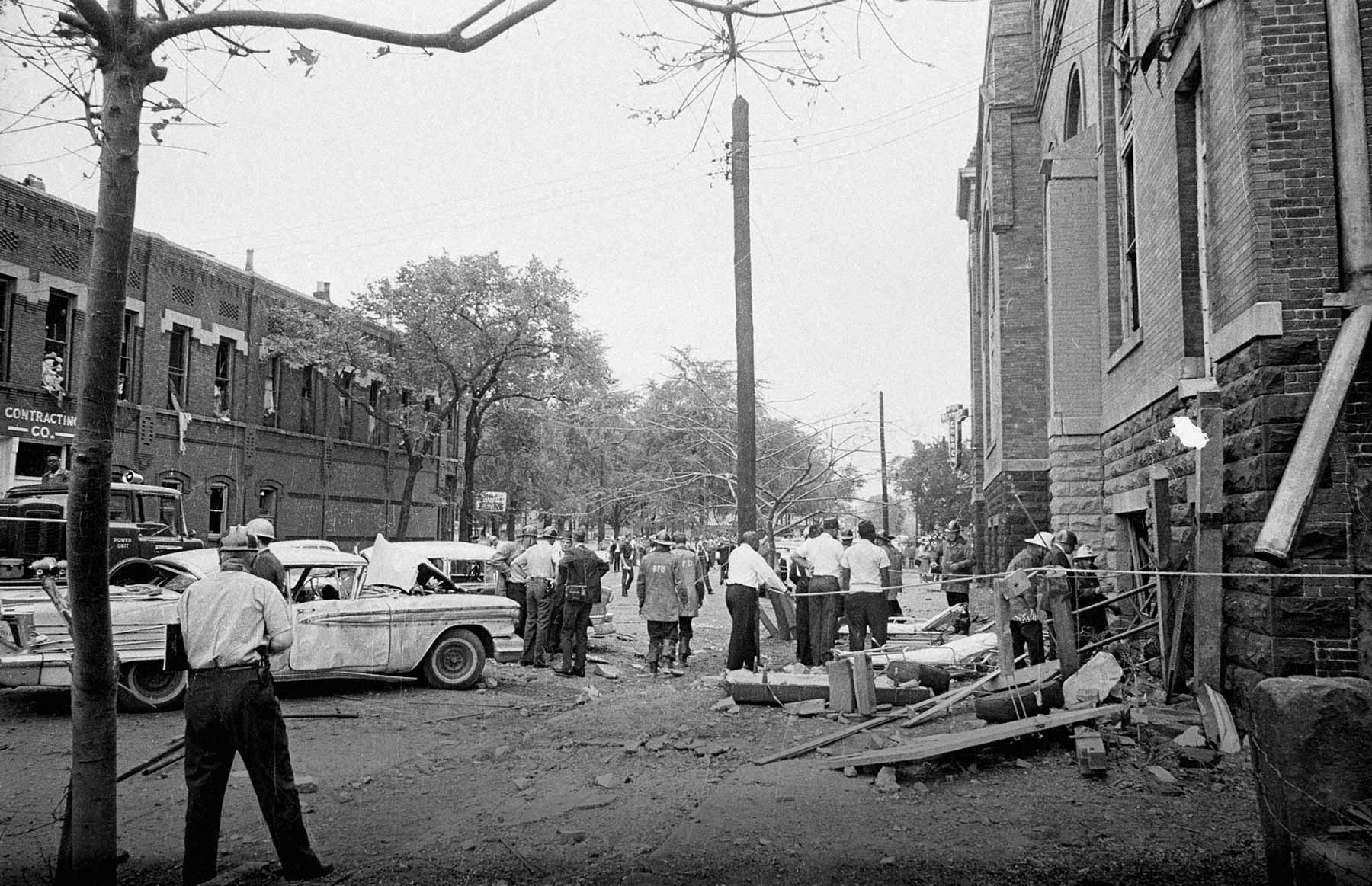
Sixteenth Street Baptist Church bombing in Birmingham, Alabama, in which four children were murdered, 1963. (Anthony Falletta/ © The Birmingham News)
Activists eventually achieved passage of landmark civil rights legislation, including the Civil Rights Act of 1964, which bars racial discrimination in workplaces and public accommodations, and the Voting Rights
Act of 1965, which finally created federal oversight to protect African American voting rights. Building on the Supreme Court’s reasoning in Brown, federal courts used these new laws and existing constitutional provisions to strike down
racial segregation in public parks, pools, beaches, courtrooms, train stations, and city buses.
In response, segregationist forces comprised of activist politicians, cultural commentators, and grassroots community groups used the same
infrastructure and identity developed in the fight against school desegregation to oppose the broader civil rights progress that followed.
The full compilation of civil rights heroes and martyrs — including many names we know and remember
— is too long to include here, but another group of actors has remained largely anonymous and unacknowledged. That roster includes white elected officials who proudly targeted civil rights activists with violence and intimidation; white community
leaders, clergy, and educators who chose to remain silent while their friends, relatives, and neighbors harassed, beat, bombed, and murdered Black people; white law enforcement officials who protected white supremacy; and Southern lawmakers who
weakly condemned the most infamous attacks while obstructing federal civil rights legislation and fanning the flames of segregationist outrage.
The bus boycott here is a painful economic injury to the company. But as a matter of the facts of life, Negro leaders should reckon with two realities: The white man’s economic artillery is far superior, better emplaced, and commanded by more experienced gunners. Second, the white man holds all the offices of government machinery. There will be white rule for as far as the eye can see. Are those not facts of life? Editorial, Montgomery Advertiser, December 13, 1955218 Montgomery (Ala.) Advertiser, “The 2-Edged Sword,” December 13,1955.
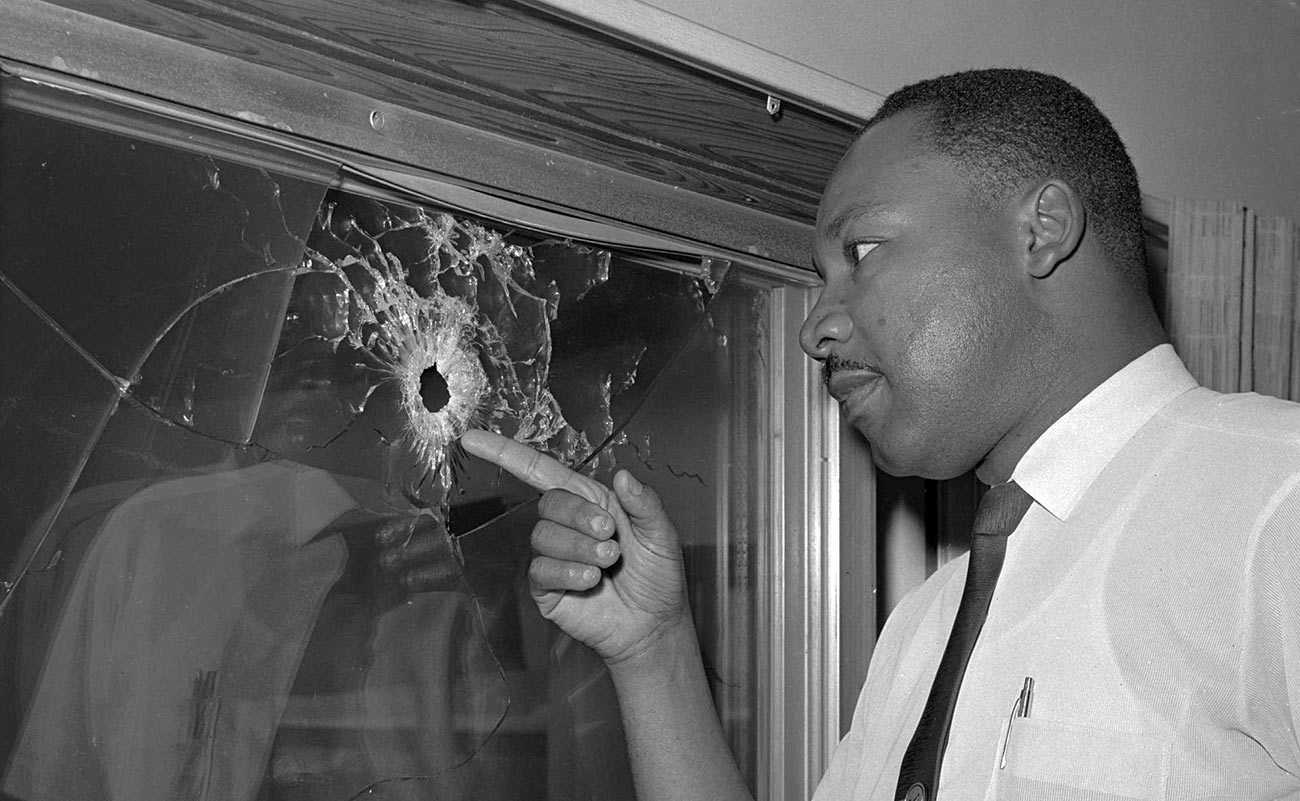
In the summer of 1964, the Southern Christian Leadership Conference organized weeks of anti-segregation demonstrations and marches in St. Augustine, Florida, during which more than 200 white residents chased and beat protestors, injuring 50 and sending 15 to the hospital. Many of the Black demonstrators, including Dr. King, were arrested.217 Ben Brotemarkle, “Florida Frontiers: St. Augustine Foot Soldiers,” Florida Today, March 12, 2015; Los Angeles Times, “Violent Fighting Halts St. Augustine March,” June 26, 1964. Dr. King inspects a bullet hole in the glass door of his rented cottage in St. Augustine, Florida, on June 5, 1964. (AP)
[T]he machinery of government gave mobs immunity. . . . Even when [law enforcement officers] did not actually ride with the Ku Klux Klan or march with the lynch mob themselves, they would not arrest racist killers. A white man charged with killing a Black man could count on his grand jury refusing to indict him, the local district attorney refusing to prosecute him, or the jury refusing to convict him. The machinery of justice . . . endorsed mob violence.219 Christopher Waldrep, African Americans Confront Lynching: Strategies of Resistance from the Civil Rights War to the Civil Rights Era (Maryland: Rowman & Littlefield, 2009), 23.
— Black journalist T. Thomas Fortune made these observations in the 1880s during the fight against lynching, but they aptly describe the situation confronting Black civil rights activists generations later.
“For the next 15 years,” a white man named Byron De La Beckwith wrote in a letter to the National Rifle Association in January 1963, “we in Mississippi are going to have to do a lot of shooting to protect our people from bad niggers.”220 Rick Bragg, “A Final Try for Truth,” Tampa Bay (Fla.) Times, February 5, 1992. A fertilizer salesman, veteran, and White Citizens’ Council member, De La Beckwith was a staunch segregationist who once declared, “I believe in segregation like I believe in God.”221 Ben Funk, “Beckwith Denies Any Part in Slaying,” Shreveport (La.) Times, February 6, 1964. When he was arrested and charged with assassinating Mississippi NAACP Field Secretary Medgar Evers on a June evening in 1963, the state-funded Mississippi State Sovereignty Commission assisted De La Beckwith’s defense. Governor Ross Barnett interrupted his trial during the testimony of Mrs. Myrlie Evers to shake the defendant’s hand, and two different all-white juries declined to convict. Remarking on the outcome of one of De La Beckwith’s two 1964 trials, Governor Barnett quipped, “You can’t be surprised what a jury does or who a woman will marry.”222 Jackson (Miss.) Clarion-Ledger, “Second Beckwith Trial May Be Held in April,” February 8, 1964.
Dozens of people died in anti-civil rights violence between 1954 and 1968,223 153 Cong. Rec. 16477 (2007) (statement of Rep. Robert Scott); DeNeen L. Brown, “Unsolved and Overlooked Murders: Investigating Cold Cases of the Civil Rights Era,” Washington Post, June 26, 2017. and countless more were injured and traumatized while fighting for equal rights. A study of violent civil rights-related incidents in the South documented more than 100 attacks between January 1, 1955, and May 1, 1958.224 Klarman, From Jim Crow to Civil Rights, 425. “Although [demonstrators] won several victories,” one scholar observed, “the U.S., particularly the South, became a war zone.”225 David C. King, Oman (New York: Marshall Cavendish Benchmark,1997), 211.
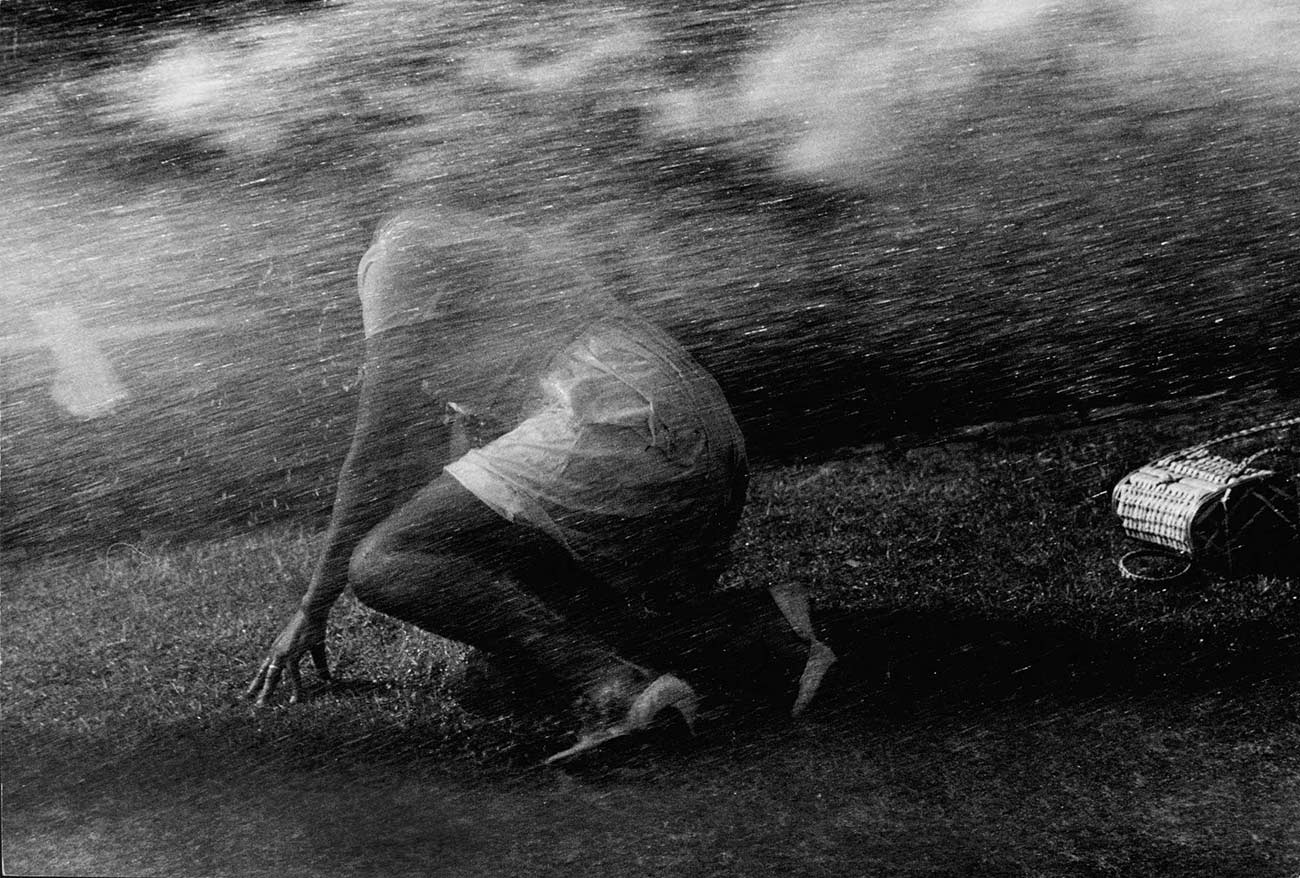
A civil rights advocate is struck by water from fire hoses wielded by police officers during a protest in Birmingham, Alabama, 1963. (Charles Moore/Getty Images)
Between 1955 and 1963, Black civil rights activists were the targets of no fewer than 21 bombings in Birmingham, Alabama (earning it the moniker “Bombingham”).
Suppressing Black voters ensured the 1942 election of James O. Eastland as United States senator from Mississippi. Eastland would build a six-term career leading a national movement opposed to civil rights.
Multiple attacks targeted movement leader Reverend Fred Shuttlesworth and an explosion at 16th Street Baptist Church killed four young Black girls in the church basement and two young Black boys in the violent aftermath.226 Elmira (N.Y.) Star-Gazette, “6 Dead in Birmingham Blast,” September 16, 1963; Jon Reed. “Virgil Ware and Johnny Robinson: Families Want History to Remember Teen Boys, Too,” AL.com, September 14, 2003, http://blog.al.com/spotnews/2013/09/virgil_ware_ and_johnny_robinso.html.
Law enforcement and white elected officials tolerated and sometimes encouraged racial violence and terrorist acts. Many law enforcement officials were members of White Citizens’ Councils or the Ku Klux Klan. 227 Brian Dooley, Black and Green: The Fight for Civil Rights in Northern Ireland & Black America (Chicago: Pluto Press, 1998), 100. FBI investigations into the murders of three civil rights workers in Neshoba County, Mississippi, concluded that local Sheriff Lawrence Rainey and Deputy Sheriff Cecil Price were involved in the crim and were active members of the Ku Klux Klan. Montgomery, Alabama, police commissioner Clyde Sellers openly joined the local White Citizens’ Council during the bus boycott. All-white juries consistently acquitted those charged with violence against Black people, effectively immunizing perpetrators of racist violence from punishment
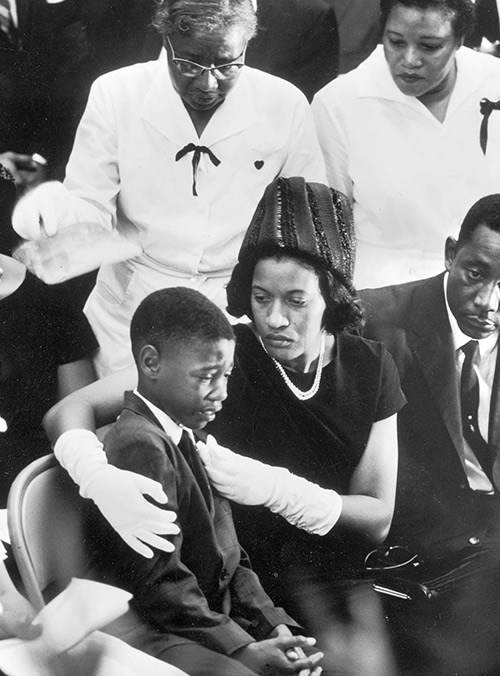 Myrlie Evers, the widow of Medgar Evers, comforts their son Darrell
at his father’s funeral. Medgar Evers was murdered on June 12, 1963, in
Jackson, Mississippi. (John Loengard/Life Magazine/The LIFE Picture
Collection/Getty Images)
In August 1955, Roy Bryant and J.W. Milam were acquitted of abducting and brutally killing Emmett Till, a Black 14-year-old visiting from Chicago, despite the testimony of multiple witnesses proving that the men targeted Emmett for allegedly insulting
Bryant’s wife.228
Hugh Stephen Whitaker, “A Case Study in Southern Justice: The Murder and Trial of Emmett Till,” Rhetoric & Public Affairs 8.2 (2005): 189-224.
Months later, both men confessed to Emmett’s murder in Look Magazine.229
William Bradford Huie, “The Shocking Story of Approved Killing in Mississippi,” Look Magazine, January 24, 1956.
Myrlie Evers, the widow of Medgar Evers, comforts their son Darrell
at his father’s funeral. Medgar Evers was murdered on June 12, 1963, in
Jackson, Mississippi. (John Loengard/Life Magazine/The LIFE Picture
Collection/Getty Images)
In August 1955, Roy Bryant and J.W. Milam were acquitted of abducting and brutally killing Emmett Till, a Black 14-year-old visiting from Chicago, despite the testimony of multiple witnesses proving that the men targeted Emmett for allegedly insulting
Bryant’s wife.228
Hugh Stephen Whitaker, “A Case Study in Southern Justice: The Murder and Trial of Emmett Till,” Rhetoric & Public Affairs 8.2 (2005): 189-224.
Months later, both men confessed to Emmett’s murder in Look Magazine.229
William Bradford Huie, “The Shocking Story of Approved Killing in Mississippi,” Look Magazine, January 24, 1956.
Dozens of people witnessed the shooting of Lamar Smith, a 63-year-old Black farmer and voting rights activist killed on the lawn of the Lincoln County Courthouse in Brookhaven, Mississippi, in August 1955. The sheriff allowed one of the
men involved in the murder to leave the scene covered in blood, and three men arrested for the killing were released without charges when the grand jury refused to indict.230
Brookhaven (Miss.) Daily Leader, “Authorities Seek Comment on 1955 Murder Cold Case,” May 12, 2009.
In December 1955, 18 months after Brown, activists in Montgomery, Alabama, launched a year-long boycott to protest mistreatment on the city’s segregated buses following the arrest of a Black rider named Rosa Parks.231
Klarman, From Jim Crow to Civil Rights, 371.
In 1956 and 1957, four Black churches and the homes of boycott leaders Dr. Martin Luther King Jr., Reverend Ralph Abernathy, Reverend Robert Graetz, and E.D. Nixon were bombed.232
Ibid., 425; Montgomery (Ala.) Advertiser, “Blast Rocks Residence of
Bus Boycott Leader,” January 31, 1956; Montgomery (Ala.) Advertiser,
“Negro Woman Withdraws Action on Segregation,” February 3,
1956; Springfield (Mo.) Leader and Press, “Dixie Solons, Violence Stoke
Race Pot Fire,” February 2, 1956; Montgomery (Ala.) Advertiser, “Graetz
Denies Bomb Hoax,” August 26, 1956; Montgomery (Ala.) Advertiser,
“Negro Churches, Residences Suffer $50,000 Bomb Damage,” January
11, 1957.
Two white men affiliated with the Ku Klux Klan were indicted after confessing to the blasts, but in May 1957, an all-white jury acquitted them of all charges as spectators cheered.233
New York Times, “2 in Montgomery Freed in Bombing; Acquitted by White Jury of Attack on Negro Church – Spectators Cheer Verdict,” May 31, 1957.
In Abbeville, Alabama, on a September night in 1944, a gang of white men kidnapped and took turns raping Recy Taylor, a young, Black, married mother, at gunpoint. After the attack, the men blindfolded Mrs. Taylor, drove her back to the road, and left her to walk home.234 Albert Deutsch, “Rape of Negress Ignored in South,” York (Pa.) Gazette and Daily, December 8, 1944.
For generations of Black women, racial terror included the constant threat of sexual assault and a complete lack of legal protection. “[T]hroughout the Jim Crow era,” wrote historian Danielle L. McGuire, “white men lured Black women and girls away from home with promises of steady work and better wages; attacked them on the job; abducted them at gunpoint while traveling to or from home, work, or church; raped them as a form of retribution or to enforce rules of racial and economic hierarchy; sexually humiliated and assaulted them on streetcars and buses, in taxicabs and trains, and in other public spaces.”235 Danielle L. McGuire, At the Dark End of the Street: Black Women, Rape, and Resistance — A New History of the Civil Rights Movement from Rosa Parks to the Rise of Black Power (New York: Knopf, 2010), xviii.
Black women’s resistance to this racialized sexual exploitation helped birth the activism and organized community action that grew into the Civil Rights Movement — even as they bore some of the era’s deepest scars. Between 1940 and 1975, civil rights campaigns in major cities throughout the South were sparked by sexual attacks against Black women.236 Ibid., xix When a local grand jury refused to indict Recy Taylor’s attackers, despite a confession, the Montgomery NAACP launched an investigation and campaign for justice spearheaded by future bus boycott leader Rosa Parks. None of Mrs. Taylor’s attackers was held accountable.237 Ibid., xvii.
The same communities that lynched and legally executed Black men for mere allegations of sexual misconduct against white women tolerated and excused white men’s sexual attacks against Black women and girls. In May 1956, after four white men kidnapped and raped 16-year-old Annette Butler in Tylertown, Mississippi, only one faced any punishment. At sentencing, Judge Thomas Pickens Brady — a vocal segregationist — scolded the defendant not for committing rape, but for bringing upon himself the shame of interracial sexual relations: “No action could be more in contrast with the beliefs of the segregationist.” 238 Charles B. Gordon, “Arraignment of Four Men Delayed as Brady Appoints their Attorneys,” McComb (Miss.) Enterprise-Journal, October 4, 1956; ibid., 117-120.
After South Carolina senator Strom Thurmond died in 2003 at age 101, the public learned that, at 22, he had fathered the child of an underage Black girl.239 Gary Younge, “Segregationist Senator had Child by Black Maid,” The Guardian, December 16, 2003. To some, it was a shocking revelation that seemed to conflict with Thurmond’s 70-year political career spent fervently defending racial separation, inequality, and the superiority of the white race. For others, it was tragically predictable.
“[I]n a climate characterized by fear and abject racial intimidation, the question of whether Carrie Butler, an impoverished maid in the Thurmond family household, freely consented is virtually meaningless,” legal scholar Kimberle Williams Crenshaw wrote in 2004. “The more telling question is whether there was any way she could freely say no.... The protection law promised was empty; after all, statutory rape laws were not written to protect girls like Butler.”240 Kimberle Williams Crenshaw, “Was Strom A Rapist?” The Nation, February 26, 2004.
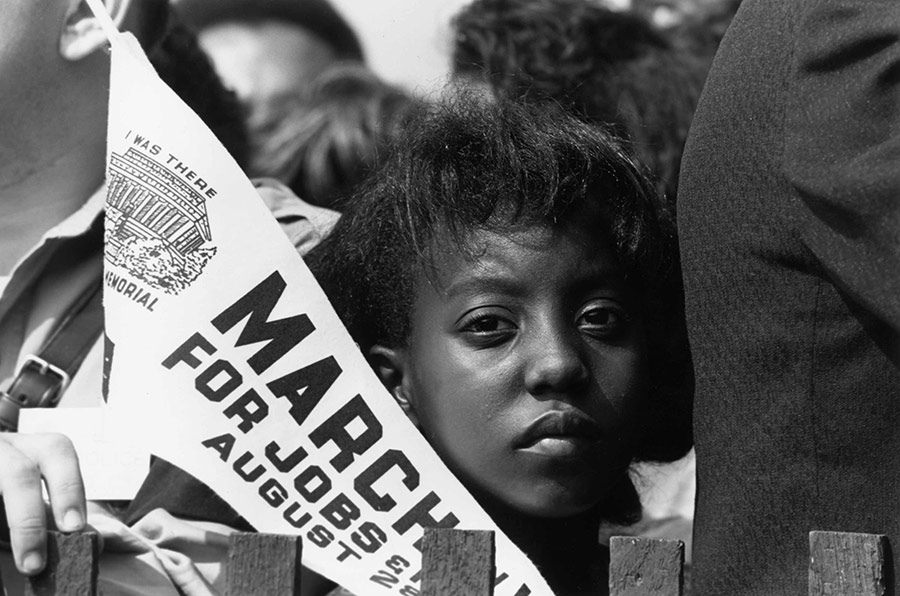
A young girl named Edith Lee Payne participating in the August 28, 1963, March on Washington. (Photo by MPI/Getty Images)
The story of opposition to the cause of civil rights cannot be separated from the plight of generations of Black women whose sexual victimization went unpunished, because those who condoned that abuse were the same men who defended segregation and fought against racial equality.
In 1965, the Honolulu Advertiser profiled Jim Clark, the notorious sheriff of Dallas County, Alabama. Clark told the reporter, “We got a sayin’ down here that every nigger baby girl born is a 12 year old—.” The newspaper cut off the quote, but explained that Clark used an unprintable word. His meaning was that every Negro girl who has reached puberty is fair game for a white man.”241 1 Gene Hunter, “Selma’s Sheriff 100 Pct. Racist,” Honolulu (Hawaii) Advertiser, March 23, 1965.
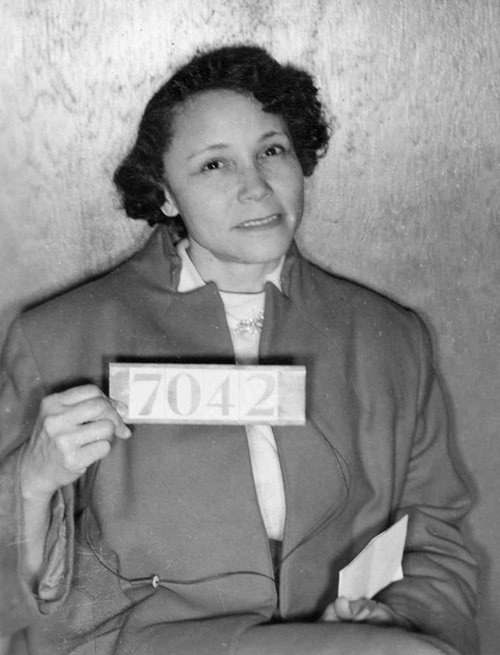 Jo Ann Robinson, a Black woman and English professor at
Alabama State College, was the “key organizer” and “backbone” of the
Montgomery bus boycott. She also faced threats and violent reprisals,
including vandalism to her home and car.251
Lynne Olsen, Freedom’s Daughters (New York: Scribner, 2001), 122, 124-25.
She was arrested for organizing the boycott in 1955. (Alabama State University)
The movement to challenge segregated lunch counters started when Black students staged a sit-in at a Woolworth’s in Greensboro, North Carolina, in February 1960. The sit-ins spread and attracted violent responses.242
Klarman, From Jim Crow to Civil Rights, 373-74
In 1960, protestors from Tougaloo College staging a sit-in at a Woolworth’s in Jackson, Mississippi, were attacked by white men who kicked one student in the face until he lost consciousness and clubbed a teacher to the floor.243
Jackson (Miss.) Free Press, “Real Violence: 50 Years Ago at Woolworth,” May 23, 2013.
That same year, white Americans armed with sticks, clubs, pipes, and whips attacked African Americans staging a “wade-in” to protest racial segregation of a public beach in Biloxi, Mississippi.244
Matthew Pitt, “A Civil Rights Watershed in Biloxi, Mississippi,” Smithsonian Magazine, April 19, 2010.
Jo Ann Robinson, a Black woman and English professor at
Alabama State College, was the “key organizer” and “backbone” of the
Montgomery bus boycott. She also faced threats and violent reprisals,
including vandalism to her home and car.251
Lynne Olsen, Freedom’s Daughters (New York: Scribner, 2001), 122, 124-25.
She was arrested for organizing the boycott in 1955. (Alabama State University)
The movement to challenge segregated lunch counters started when Black students staged a sit-in at a Woolworth’s in Greensboro, North Carolina, in February 1960. The sit-ins spread and attracted violent responses.242
Klarman, From Jim Crow to Civil Rights, 373-74
In 1960, protestors from Tougaloo College staging a sit-in at a Woolworth’s in Jackson, Mississippi, were attacked by white men who kicked one student in the face until he lost consciousness and clubbed a teacher to the floor.243
Jackson (Miss.) Free Press, “Real Violence: 50 Years Ago at Woolworth,” May 23, 2013.
That same year, white Americans armed with sticks, clubs, pipes, and whips attacked African Americans staging a “wade-in” to protest racial segregation of a public beach in Biloxi, Mississippi.244
Matthew Pitt, “A Civil Rights Watershed in Biloxi, Mississippi,” Smithsonian Magazine, April 19, 2010.
When students at Alabama State College, a traditionally Black college in Montgomery, Alabama, staged a sit-in at a segregated lunch counter in the county courthouse in 1960, Governor John Patterson threatened to terminate the college’s funding
unless it expelled the student organizers and warned that “someone [was] likely to be killed” if the protests continued.245
Childress (Tex.) Index, “Negro Students March on State Capitol, Sing and Return to Classes,” March 1, 1960.
The college expelled nine students.246
ASU Today Magazine, “Historic Graduation: Righting a Wrong,”
Summer 2010; Dixon v. Alabama State Bd. of Educ., 186 F. Supp. 945, 952
(M.D. Ala. 1960), reversed by 294 F.2d 150 (5th Cir. 1961) (holding that
due process requires notice and some opportunity for hearing before a
student at a tax-supported college can be expelled for misconduct).
In August 1960, Florida activists organized several days of sit-in protests at the segregated Woolworth’s in Jacksonville. On August 27, several thousand white men armed with ax handles and baseball bats and waving Confederate flags attacked
African Americans as they walked through a park to join the demonstration. Charlie Davis, a 27-year-old Black man, was killed in the violence that erupted that day; more than 70 people were severely injured and 150 were arrested.
247
Chicago Defender, “Study Race Violence at Rally,” September 5, 1960.
Mayor W. Haydon Burns told the press: “We regret there were irresponsible elements of the citizenry who would take the law into their own hands, and this includes members of both races.”248
Tampa (Fla.) Tribune, “Jax Mayor Clamps Lid On City,” August 29, 1960.
When activists renewed the sit-ins in October, the Klan kidnapped a Black 16-year-old, drove him outside town, stripped him naked, and beat him with a belt and a pistol.249
Chicago Defender, “3 Klansmen Pistol-Whip Florida Boy, 16: First Sit-In Staged After Race Violence,” October 10, 1960.
In 1961, SNCC field secretary Bob Moses was taking two Black residents to the Amite County, Mississippi, courthouse to register to vote when he was attacked and severely beaten by a white man. Mr. Moses pressed charges and after he testified
at trial against his attacker — Bill Caston, a cousin of the local sheriff — he was advised to leave the county to avoid further violence. Caston was acquitted by an all-white jury.250
“The Struggle for Voting Rights in Mississippi — the Early Years,”
Civil Rights Movement Veterans, http://www.crmvet.org/info/voter_
ms.pdf; “A Chronology of Violence and Intimidation in Mississippi
Since 1961,” Civil Rights Movement Veterans (April 4, 1963), http://
www.crmvet.org/docs/sncc_ms_violence.pdf; Bryce Wilson Stucki,
“Moses of Mississippi,” American Prospect, August 30, 2013; Doug
McAdam, Freedom Summer (New York: Oxford University Press,
1988), 27; John Emmerich and Charles B. Gordon, “Court Acquits
White Man on Negro Beating Charge,” McComb (Miss.) Enterprise Journal,
September 1, 1961.
Criminal law has been used to maintain racial control since the end of the Civil War.252 Edward Ayers, Vengeance and Justice: Crime and Punishment in the 19th Century American South (New York: Oxford University Press, 1984), 187. A Mississippi official remarked in 1865, “Emancipation . . . will require a system of prisons.” In the 1960s, nearly a century after Emancipation, elected officials denounced peaceful civil rights protestors as “criminals” and “law breakers” and used the legal system to harass, beat, arrest, and imprison activists.253 Klarman, From Jim Crow to Civil Rights, 412. The law protected white supremacy rather than racial equality, and persecuted those who opposed the racial status quo. “The Community Relations Service (CRS) of the Justice Department, established under the Civil Rights Act of 1964, reported police brutality and other violence against Black people that went unpunished throughout the 1970s,” wrote historian Mary Frances Berry, “while the FBI and the Justice Department’s Civil Rights Division spent their time in surveillance of Black individuals and groups.”254 Mary Frances Berry, Black Resistance/White Law: A History of Constitutional Racism in America (New York: Penguin, 1995), 73-74.
A week after 17-year-old Deborah Bracy and several other Black students integrated the high school in Wetumpka, Alabama, she was arrested, charged with assault, and jailed overnight for poking a white classmate with a pencil.255 Montgomery (Ala.) Southern Courier, “Girl Accused of Assault,” September 25, 1965.
Clyde Kennard, a Black veteran, was targeted by the Mississippi Sovereignty Commission after he applied to all-white Mississippi Southern College in Hattiesburg in 1955. When surveillance and investigations failed to discredit him, officials charged him with minor allegations of theft and alcohol possession. An all-white jury convicted Mr. Kennard of stealing $25 worth of chicken feed and he was sentenced to seven years in prison, where he died from undiagnosed colon cancer in 1963. He was 36 years old.256 Timothy J. Minchin and John A. Salmond, “Clyde Kennard: A Little-Known Civil Rights Pioneer,” Mississippi History Now (2010), http://www.mshistorynow.mdah.ms.gov/articles/349/clyde-kennarda-little-known-civil-rights-pioneer.
In response to the Montgomery bus boycott, police arrested scores of Black activists and carpool drivers on phony traffic charges and tried to disbar the Black lawyer who filed the lawsuit challenging bus segregation.257 Klarman, From Jim Crow to Civil Rights, 412.
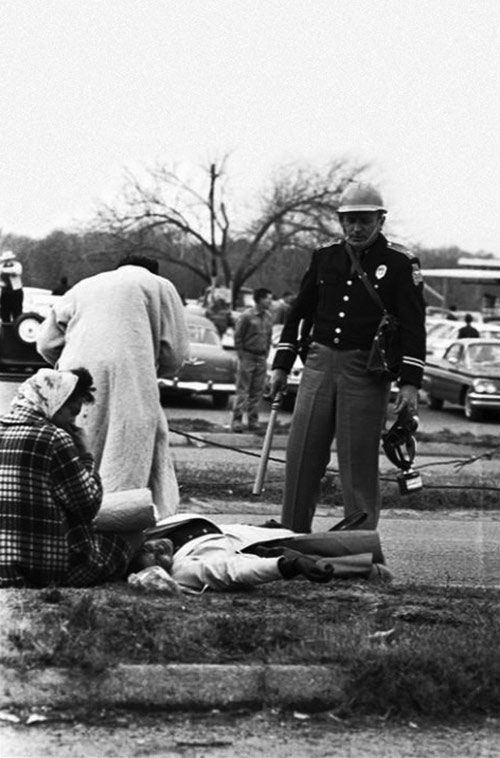 Amelia Boynton is beaten unconscious by state troopers in Selma,
Alabama, on March 7, 1965. (© Spider Martin)
Rosa Parks, Dr. Martin Luther King Jr., Reverend Ralph Abernathy, and boycott organizer Jo Ann Robinson were among 89 leaders arrested and charged with organizing an illegal boycott.258
Montgomery (Ala.) Advertiser, “Rosa Parks’ Arrest on This Day in 1955 Sparked the Montgomery Bus Boycott and Changed the World,” December 1, 2017.
The grand jury wrote: “In this state we are committed to segregation by custom and law. We intend to maintain it.”259
Cheryl Fisher Phibbs, The Montgomery Bus Boycott: A History and Reference Guide (Santa Barbara: ABC-CLIO, 2009), 52.
Amelia Boynton is beaten unconscious by state troopers in Selma,
Alabama, on March 7, 1965. (© Spider Martin)
Rosa Parks, Dr. Martin Luther King Jr., Reverend Ralph Abernathy, and boycott organizer Jo Ann Robinson were among 89 leaders arrested and charged with organizing an illegal boycott.258
Montgomery (Ala.) Advertiser, “Rosa Parks’ Arrest on This Day in 1955 Sparked the Montgomery Bus Boycott and Changed the World,” December 1, 2017.
The grand jury wrote: “In this state we are committed to segregation by custom and law. We intend to maintain it.”259
Cheryl Fisher Phibbs, The Montgomery Bus Boycott: A History and Reference Guide (Santa Barbara: ABC-CLIO, 2009), 52.
As a movement leader, Dr. King was routinely targeted by Southern law enforcement. Between the start of the Montgomery bus boycott and his 1968 assassination, Dr. King was arrested, jailed, and fined more than 25 times, in Montgomery,
Alabama, in 1956 and 1958; Atlanta in 1960; Albany, Georgia, in 1961 and 1962; Birmingham, Alabama, in 1963 and 1967; St. Augustine, Florida, in 1964; and Selma, Alabama, in 1965.
260
The King Center, “FAQs,” http://www.thekingcenter.org/faqs.
He was not alone.
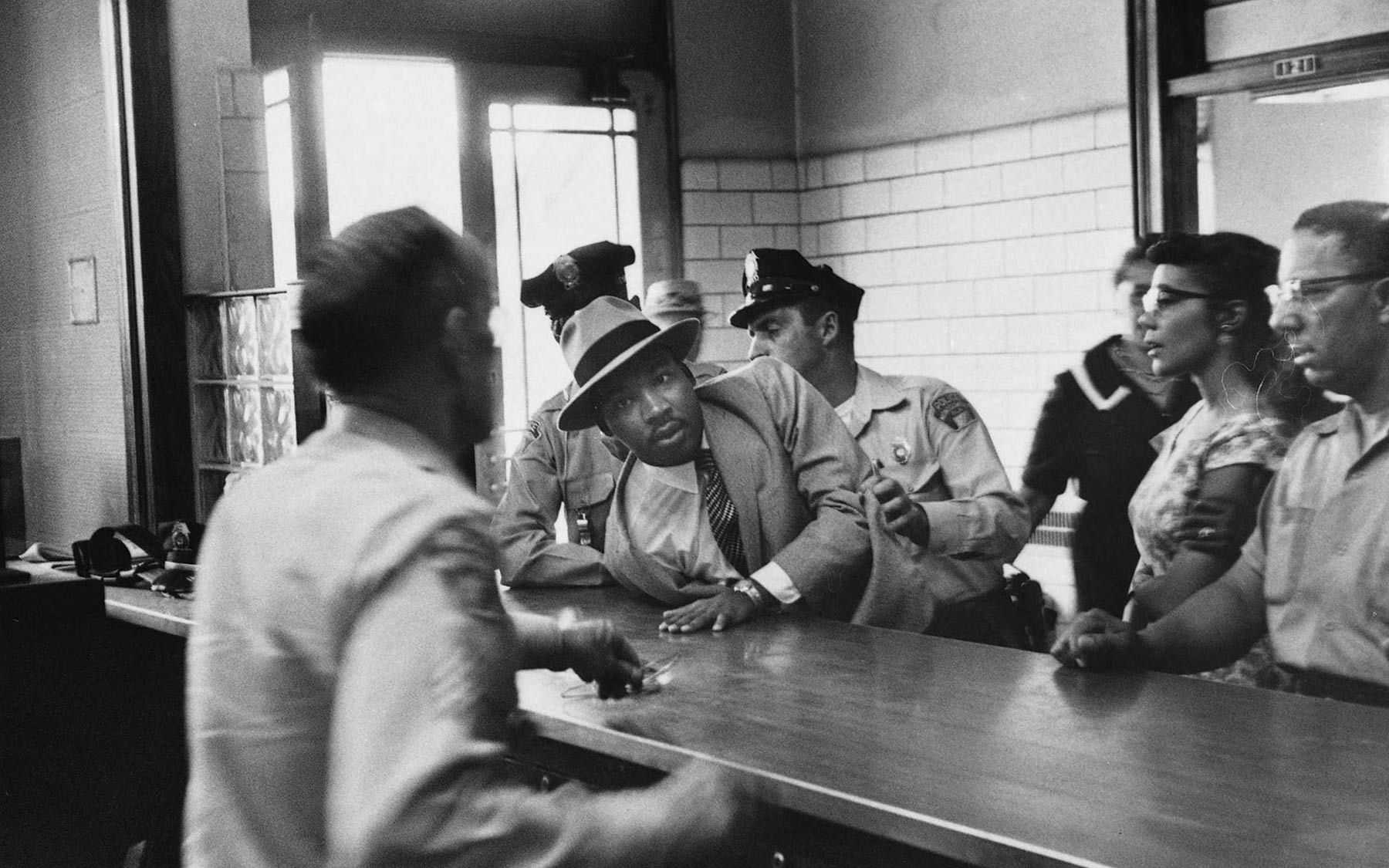
Martin Luther King Jr. is booked at the Montgomery Jail in 1958 for civil rights activism. (Charles Moore/Getty Images)
After two Florida A&M students were arrested for sitting in the “white section” of a bus in Tallahassee, the Black community launched a boycott modeled after the Montgomery effort. Boycott organizers and participants faced similar harassment. In October 1956, 21 carpool drivers and nine boycott leaders were arrested for allegedly not having proper car tags. After a three-day trial, they were convicted; some were sentenced to pay fines and some were sent to jail.261 Atlanta Daily World, “Leaders Of Bus Protest Group Fined In Fla.,” October 21, 1956; Baltimore (Md.) Afro-American, “‘Ride Buses Or Go To Jail,’ Fla.Warns: Arrest 22, Grab Books of Drivers,” October 13, 1956; Chicago Defender, “Boycotters Fined $500,” October 27, 1956; Norfolk (Va.) Journal and Guide, “Florida Bus Boycotters Appeal $11,000 Fines,” October. 27, 1956
When police officer George Booker stood trial in Selma, Alabama, in 1945 for clubbing to death a 70-year-old Black woman named Niecey Brown while he was off-duty and drunk, his lawyer cautioned the all-white jury, “If we convict this brave man who is upholding the banner of white supremacy by his actions, then we may as well give all our guns to the niggers and let them run the Black Belt.”262 Civil Rights Congress, We Charge Genocide: The Historic Petition to the United Nations for Relief from a Crime of the United States Government Against the Negro People (New York: Civil Rights Congress, 1951), 60; Selma (Ala.) Times Journal, “Booker Murder Case Before Court Today,” July 5, 1945. After minutes of deliberation, Booker was acquitted.263 Civil Rights Congress, We Charge Genocide, 60.
In the strictly maintained racial caste system that sparked the Civil Rights Movement, police departments were largely restricted to white officers,264 W. Marvin Dulaney, Black Police in America (Indianapolis: Indiana University Press, 1996), 30. who were exalted as defenders of racial hierarchy. 265 Civil Rights Congress, We Charge Genocide, 225. Police officers used violence and brutality to maintain racially biased social conditions.
“Almost daily,” the Louisiana Weekly wrote on February 11, 1939, “stories of horrible examples of what physical brutality and sworn protectors of the law wreak upon hapless, helpless individuals, which however skeptical cannot refute the evidence of as offered by men’s bruised and scarred bodies.”266 Editorial, Louisiana Weekly, “No Excuse for Police Brutality,” February 11, 1939. Eleven years later, the same paper reported that African Americans were “alarmed and displeased at the readiness of local police to use their clubs and pistols frequently without provocation. [We] do not expect this coroner to find citizens to have died from ‘natural causes’ when undertakers and private citizens find such persons have been shot through the head or back.”267 Civil Rights Congress, We Charge Genocide, 226.
Though sparked by the arrest of Rosa Parks, the Montgomery Bus Boycott and the modern Civil Rights Movement also responded to years of mistreatment, violence, and killings by police officers. In the summer of 1950 alone, two African American men were murdered on Montgomery city buses: 20-year-old Thomas Edward Brooks was beaten and shot by police for ignoring a bus driver’s order to board through the back door, and Hilliard Brooks, accused of causing a disturbance, was killed on a bus in a police shooting that also wounded two bystanders.268 Donnie Williams and Wayne Greenhaw, The Thunder of Angels (Chicago: Chicago Review Press, 2006), 8-13; Jo Ann Robinson, The Montgomery Bus Boycott and the Women Who Started It (Knoxville: University of Tennessee Press, 1987), 21-23. In both cases, officers were never held accountable. 269 Fitzgerald Paige, “U.S. Department of Justice Civil Rights Division Cold Case Initiative” (2010): 2; Williams and Greenhaw, Thunder of Angels, 14.
As the Civil Rights Movement taught effective tactics for opposing segregation and racial inequality, police brutality increasingly motivated activists and inspired civil rights protests. Peaceful marches and sit-ins — like the 1963 Children’s Crusade in Birmingham, Alabama, and the attempted Selma-to-Montgomery March in 1965 — were met with police batons, dogs, and firehoses. As one Birmingham city council member explained, “Negroes have been whipped as long as there’s been a jail. It will be that way as long as there’s a decent police force. It has to be that way.”270 Birmingham (Ala.) Post, “Fair Beatings Aired: Move to Fire Police Fails by One Vote,” May 14, 1940.
Once the classic method of lynching was the rope. Now it is the police man’s bullet.
As racial terror lynching raged in the South, millions of African Americans fled to urban centers in the North and West during the early 20th century but found little reprieve.271 Equal Justice Initiative, Lynching in America: Confronting the Legacy of Racial Terror (3d Ed. 2017), https://lynchinginamerica.eji.org/report/. The Civil Rights Congress (CRC), an interracial civil rights organization founded in Detroit in 1946, filed a petition with the United Nations in 1951 detailing 152 killings and 344 acts of violence suffered by African Americans within the previous six years. 272 Civil Rights Congress, We Charge Genocide. Titled “We Charge Genocide,” the petition demanded international attention to the plight of Black people in the United States.273 United States Genocide Convention, Article II, Convention on the Prevention and Punishment of the Crime of Genocide (December 9, 1948).
“There was a time when racist violence had its center in the South, but as the Negro people spread to the north, east, and west seeking to escape the southern hell, the violence . . . followed them,” 274 Civil Rights Congress, We Charge Genocide, 8. wrote the CRC. “Once the classic method of lynching was the rope. Now it is the police man’s bullet.”275 Ibid. The United Nations did not formally acknowledge the petition, and the violence continued.
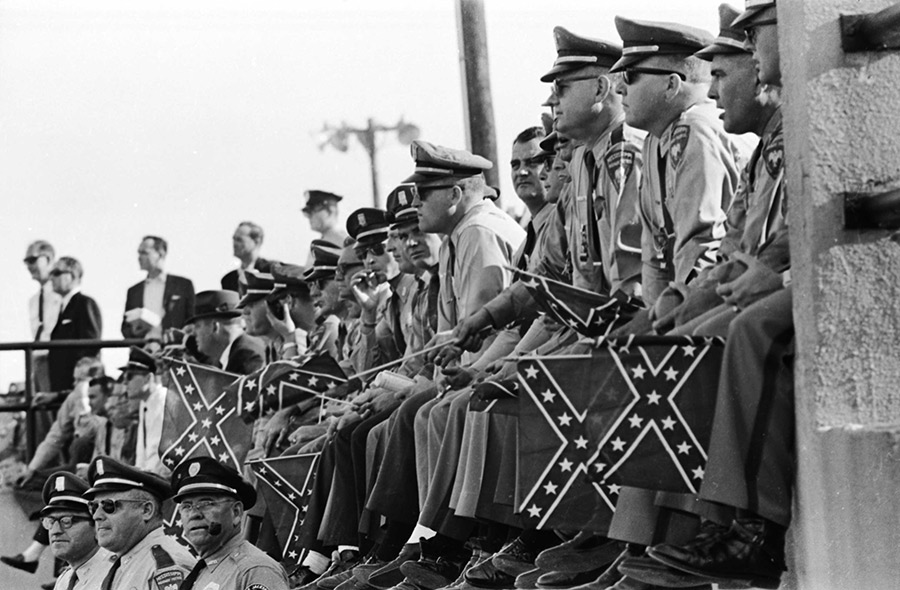
Mississippi Highway Patrolmen watch marchers as they arrive in Montgomery on March 25, 1965. (Alabama Department of Archives and History. Donated by Alabama Media Group / Photo by Spider Martin, Birmingham News)
On February 5, 1946, in Long Island, New York, Private First Class Charles Ferguson and his brother Alfonso were murdered by patrolman Joseph Romeika for protesting segregation at a local café. 276 Ibid., 61. Their brother, Seaman Third Class James Ferguson, was wounded. The three brothers had gathered to wish farewell to Charles, who was about to deploy to Europe.277 Kimberly L. Phillips, War! What is it Good For?: Black Freedom Struggles and the U.S. Military from World War II to Iraq (Chapel Hill: UNC Press, 2012), 91. As they walked from the café to the bus stop, they ran into Romeika, who pulled his gun and ordered them to stand against the wall with their hands up. 278 Ibid.; New York Times, “Brothers Describe Freeport Shooting,” July 18, 1946. The brothers complied, but Romeika kicked Charles in the groin and then shot him in the head. Romeika then “just fired again for no good reason,” killing Alfonso.279 Phillips, War!, 145-46. An investigation revealed that none of the brothers was armed. A Nassau County jury refused to indict Romeika, and instead accepted his claim that the shooting was in self-defense.280 Ibid.
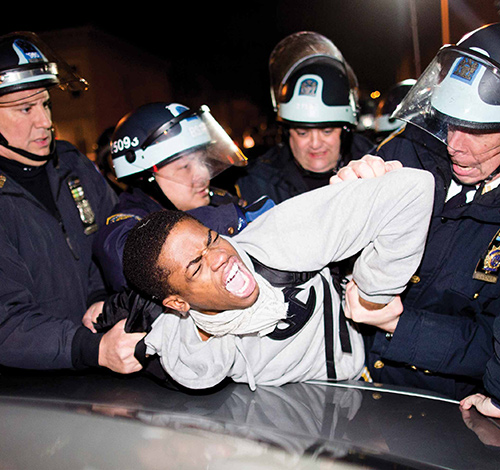 New York City police arrest a demonstrator during a march held for 16-year-old Kimani Gray, who was shot to death on a Brooklyn
street by plainclothes police officers in 2013. (AP Photo/John Minchillo)
Black men returning from military service were deemed particularly dangerous to America’s racial status quo, and police often targeted them. On August 6, 1947, a white rookie patrolman approached a disabled African American veteran named Chris Jones as
Mr. Jones was singing with friends near an entrance to Central Park in New York City. The patrolman ordered Mr. Jones to move, then beat him with a nightstick for moving too slowly. When Mr. Jones tried to shield himself, the officer shot him
three times in the stomach. Mr. Jones survived and was charged with disorderly conduct; the NYPD refused to discipline the officer.281
Themis Chronopoulos, “Police Misconduct, Community Opposition, and Urban Governance in New York City 1946-1965,” J.Urban History (April 12, 2015): 4.
New York City police arrest a demonstrator during a march held for 16-year-old Kimani Gray, who was shot to death on a Brooklyn
street by plainclothes police officers in 2013. (AP Photo/John Minchillo)
Black men returning from military service were deemed particularly dangerous to America’s racial status quo, and police often targeted them. On August 6, 1947, a white rookie patrolman approached a disabled African American veteran named Chris Jones as
Mr. Jones was singing with friends near an entrance to Central Park in New York City. The patrolman ordered Mr. Jones to move, then beat him with a nightstick for moving too slowly. When Mr. Jones tried to shield himself, the officer shot him
three times in the stomach. Mr. Jones survived and was charged with disorderly conduct; the NYPD refused to discipline the officer.281
Themis Chronopoulos, “Police Misconduct, Community Opposition, and Urban Governance in New York City 1946-1965,” J.Urban History (April 12, 2015): 4.
That November, a 20-year-old Black military veteran named Roland T. Price argued with a white bartender in a restaurant near the Canadian border in Rochester, New York.282 Civil Rights Congress, We Charge Genocide, 68. When the bartender grabbed a pistol and called the police, Patrolman William Hamill entered the restaurant with his gun drawn and ordered Mr. Price to step outside, where five police officers were waiting. They opened fire on Mr. Price and shot him 25 times. The shooting was deemed “justified” even though Mr. Price was unarmed and there was no evidence he resisted.283 Michael Newton, Unsolved Civil Rights Murder Cases, 1934-1970 (Jefferson, N.C.: McFarland, 2016), 163. In October 1945 in Harlem, New York, police “emptied their guns” into an unidentified African American man who was driving on West 144th Street and 8th Avenue. Eyewitnesses said the man had been pursued by a police car but had “his hands raised in surrender” when he was shot. When a crowd gathered in protest, police reinforcements arrived and clubbed the protestors.284 Civil Rights Congress, We Charge Genocide, 59; Chronopoulos, “Police Misconduct,” 4. This violent response to protestors would become increasingly familiar as challenges to the racial caste system gained momentum over the next two decades.
On March 7, 1965, state and local police brutally attacked hundreds of civil rights protestors in Selma, Alabama, knocking marchers to the ground, hitting them with sticks, and chasing them on horseback while swinging clubs, whips, and rubber tubing wrapped in barbed wire. 285 Christopher Klein, “Remembering Selma’s Bloody Sunday,” March 6, 2015, https://www.history.com/news/selmas-bloody-sunday-50-years-ago. John Lewis of SNCC and Reverend Hosea Williams of the SCLC led the attempted march to Montgomery, Alabama, to protest the widespread violation of African American voting rights and the recent murder of 26-year-old activist Jimmie Lee Jackson, who was shot and killed by a white state trooper named James Fowler on February 18.286 Leada Gore, “Alabama Trooper Who Killed Jimmie Lee Jackson Ill, Family Says They Want No Part of Selma,” March 8, 2015, http://www.al.com/news/index.ssf/2015/03/alabama_trooper_who_killed_jim.html. As a result of the police attack, dozens of civil rights activists were hospitalized with severe injuries and more than 750 were arrested.287 Athena Jones, “Selma 50 Years Later: Memories from Bloody Sunday Nurse,” CNN, March 5, 2015; San Mateo (Calif.) Times, “More Negroes Are Arrested in Alabama,” February 3, 1965.
On February 8, 1968, white state troopers fired into a crowd of Black students on the campus of historically Black South Carolina State College in the town of Orangeburg during a protest of a segregated bowling alley.
Police wounded 28 people and killed three: 18-year-old Samuel Hammond, 18-year-old Henry Smith, and 17-year-old Delano Middleton. Nine officers were charged in the shooting and claimed self defense, despite no evidence that any of the protestors were armed. None of the officers was convicted, and Governor Robert McNair blamed the violence on “Black Power advocates.” Cleveland Sellers, a young Black leader of SNCC, was shot in the shoulder during the police attack and ended up the only person punished; he was convicted of rioting and served seven months in jail.288 Tim Arango, “Films Revisit Overlooked Shootings on a Black Campus,” New York Times, April 16, 2008; Jack Bass, “Orangeburg Massacre,” South Carolina Encyclopedia, June 8, 2016.
In the 1960s, Black communities fed up with police brutality responded to police harassment, abuse, and killings with riots in several major cities, including Harlem (1964), Philadelphia (1964), Chicago (1966), Detroit (1967), and Newark (1967). 289 Newsweek, “The Rampage After the Slaying of Martin Luther King Jr.,” April 15, 1968. In the summer of 1965, a police stop of two young Black men in the Watts neighborhood of Los Angeles erupted into community unrest when the men were beaten and arrested after an altercation between police and their mother.290 Los Angeles Times, “Rena Price Dies at 97; Her and Her Son’s Arrests Sparked Watts Riots,” June 22, 2013. Pockets of rioting soon erupted throughout the 20-block area of Watts and lasted for six days, leaving 34 dead, 1032 injured, nearly 4000 arrested, and $40 million in damage.291 Governor’s Commission on the Los Angeles Riots, “Violence in the City - An End or a Beginning?” (1965).
A commission convened to investigate the riot reported in December 1965 that Watts’ Black residents’ dissatisfaction with policing, high unemployment rates, poor housing, and inadequate schools had directly led to the uprising. 292 Ibid. Despite the findings, little was done to address the conditions. In 1991, 26 years later, a federal court concluded that Los Angeles sheriff’s deputies continued to use racially motivated “terrorist-type tactics” to violate the civil rights of African Americans.293 Los Angeles Times, “Deputies in ‘Neo-Nazi’ Gang, Judge Found Sheriff’s Department Many at Longwood Office Have Engaged in Racially Motivated Violence Against Blacks and Latinos,” October 12, 1991.
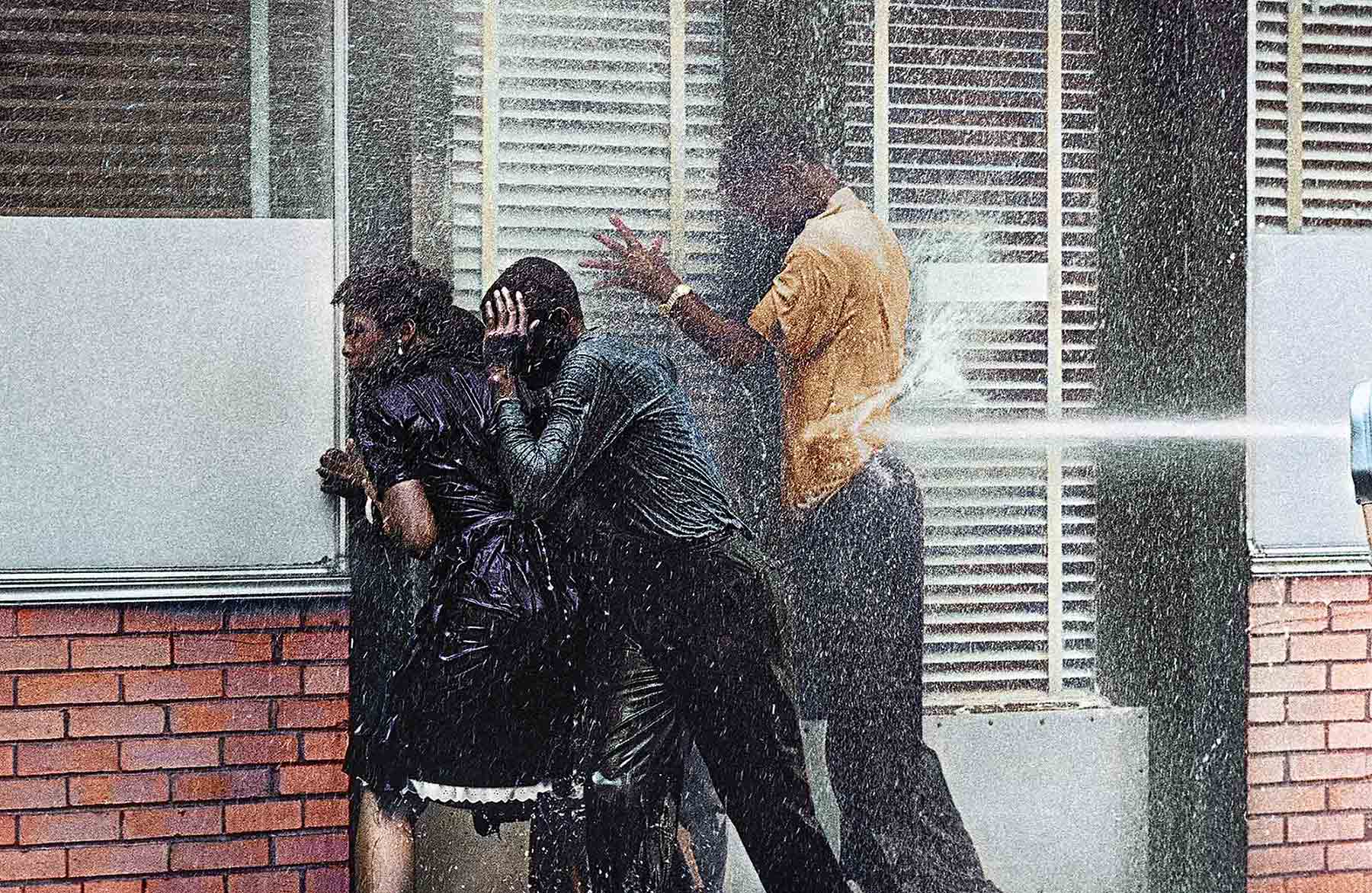
Firemen use high-pressured water jets to hose civil rights protestors in Birmingham, Alabama, in 1963. (Charles Moore/Getty Images, color by Marina Amaral)
“For more than a decade — from the mid-1950s until the late 1960s,” wrote Michelle Alexander, officials who opposed civil rights systematically and strategically framed their rhetoric as “calls for law and order, arguing that Martin Luther King Jr.’s
philosophy of civil disobedience was a leading cause of crime.”294
Michelle Alexander, The New Jim Crow (New York: New Press, 2010), 40-41.
Some segregationists even claimed that integration caused crime, and found their rhetoric bolstered by suspect but highly publicized FBI reports of dramatic increases in the national crime rate.295
Ibid., 41.
By criminalizing civil rights activists, opponents of civil rights shifted the public debate from segregation to crime.296
Ibid., 42; see also Lewis, Massive Resistance, 143-44.
Officials who opposed civil rights systematically and strategically framed their rhetoric as “calls for law and order, arguing that Martin Luther King Jr.’s philosophy of civil disobedience was a leading cause of crime.”
In the 1968 presidential election, both Richard Nixon and former Alabama Governor George Wallace made “law and order” a central theme of their campaigns; combined, they won 57 percent of the vote.297 Alexander, New Jim Crow, 46. Nixon ran one ad that “explicitly called on voters to reject the lawlessness of civil rights activists and embrace ‘order’ in the United States.” 298 Ibid., 46.
It was a popular message. By 1968, 81 percent of Americans agreed that “law and order has broken down in this country” and the majority blamed “Negroes who start riots” and “Communists.”299 Ibid., 45.
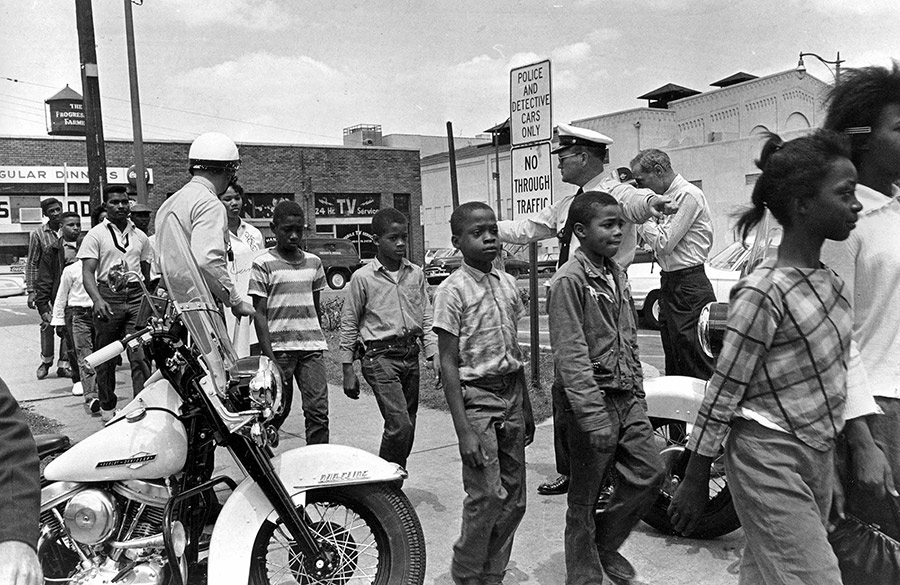
On May 4, 1963, police arrest and jail Black school children in Birmingham, Alabama for protesting against racial discrimination. (AP Photo/Bill Hudson)
On May 2, 1963, on the orders of Birmingham police chief Eugene “Bull” Connor, more than 1000 African American schoolchildren marching for civil rights in the downtown district were blasted with high-pressure firehoses, clubbed by police, and attacked by police dogs. Led by organizers including Dr. Martin Luther King Jr. and Reverend Fred Shuttlesworth, hundreds of children came out to march day after day, even as they continued to be attacked and arrested. 300 Don McKee, “Birmingham Jails 700 in Protest,” Tallahassee (Fla.) Democrat, May 3, 1963; McWhorter, Carry Me Home, 365-378.
“You must understand that a Bull Connor cannot exist without the nods of the status quo people,” Chris McNair explained in 4 Little Girls, a 1997 film depicting the 16th Street Baptist Church bombing that killed his daughter, Denise, and three other young Black girls. “He may be the person who actually does the talking; but believe me the Bull Connors have the blessings of someone else.”301 Chris McNair, “4 Little Girls,” Doc., Directed by Spike Lee (1997; Brooklyn: 40 Acres and a Mule Filmworks/HBO), Film.
Photographs and television footage showing children being brutally assaulted provoked shock and outrage from many Americans who tolerated segregation but were uncomfortable seeing it so fiercely enforced. “Birmingham’s barbarism highlights an inescapable conclusion,” wrote journalist Ralph McGill. “It is that the nation’s single most important internal problem at this place and time in history is how we deal with minorities. To say that the security of the nation is in the final balance is no overstatement.” 302 Gene Roberts and Hank Klibanoff, The Race Beat: The Press, the Civil Rights Struggle, and the Awakening of a Nation (New York: Random House, 2006), 323.
More than 2000 children and adult demonstrators had been arrested by May 10, when activists reached an agreement with the city to stop the demonstrations in exchange for the release of arrested protestors and desegregation of downtown shops. Violent repression continued, however, as segregationists angered by the agreement set off bombs across the city, and the white-controlled school board suspended or expelled children who participated in the march.303 Lottie L. Joiner, “How the Children of Birmingham Changed the Civil-Rights Movement,” Daily Beast, May 2, 2013; Charlayne HunterGault, “Fifty Years After the Birmingham Children’s Crusade,” New Yorker, May 2, 2013.
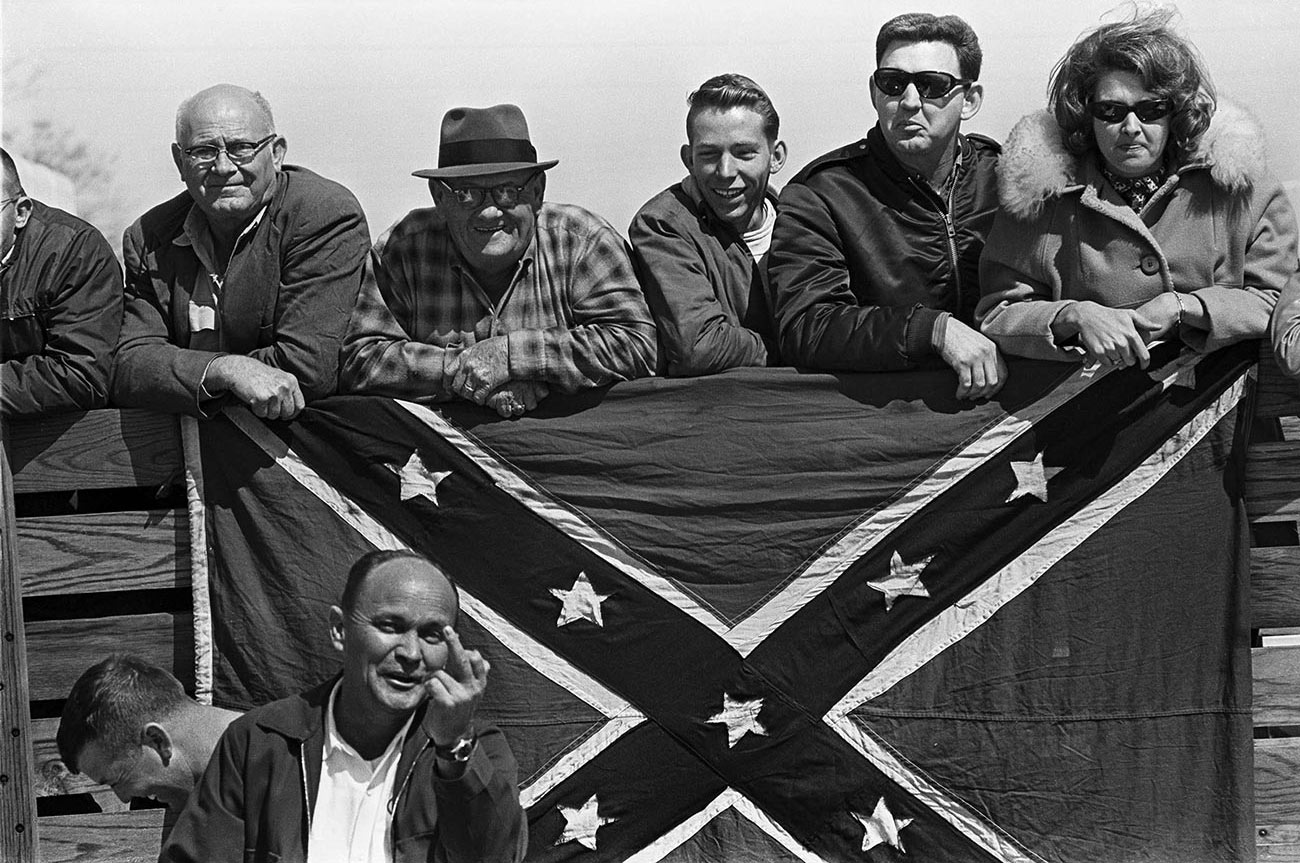
Segregationists taunt peaceful civil rights protestors as they march from Selma to Montgomery in March 1965. (Spider Martin)
In 1927, white lynch mobs in Burke County, North Carolina, searched for a Black man named Broadus Miller. In an era when allegations against Black people were rarely questioned and Black men accused of serious crimes against white women were more likely to be lynched than tried in court, few expected that Mr. Miller, who was accused of killing a white girl, would live to see the inside of a courtroom. A young attorney named Samuel J. Ervin told the county sheriff to invoke a state law that authorized any citizen to kill a suspect, and then Ervin delivered firearms to the lynch mob. Within days, Mr. Miller was shot dead and delivered to the county jail, where his corpse was “placed on the steps so the milling thousands could pass by and look at the object of their hatred.” 304 Statesville (N.C.) Record & Landmark, “Broadus Miller is Killed in Gun Duel,” July 4, 1927; Danville (Va.) Bee, “Searchers of Negro Given A Clean Bill,” July 6, 1927.
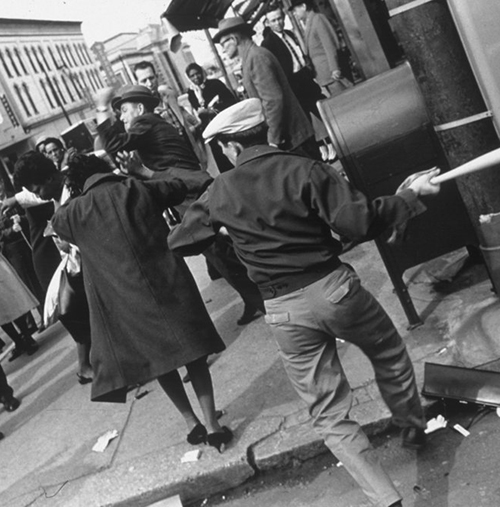 After Black students sought service at a segregated Montgomery cafeteria in 1960, angry white residents attacked Black shoppers. A white man with
a baseball bat swings at a Black shopper, while another attacks a Black woman with a closed fist. (Charles Moore/Getty Images)
Weeks after Brown was announced in 1954, Samuel J. Ervin by then a justice on the North Carolina Supreme Court — was appointed to a vacant seat in the Senate.305
Kannapolis (N.C.) Daily Independent, “Umstead Appoints Sam Ervin to Senate Post,” June 6, 1954.
In response to Brown, he told a local reporter, “I don’t see why our Constitution meant one thing for 86 years and why it now means another” and called the ruling a “tragedy.”306
Burlington (N.C.) Daily Times-News, “Ervin Raps Ruling on Segregation,” June 10, 1954.
He was sworn in days later. Senator Ervin signed the Southern Manifesto and spent most of his 20 years in Congress opposing desegregation, obstructing civil rights legislation, and backing racial violence and injustice just as he did in Burke
County decades earlier.
After Black students sought service at a segregated Montgomery cafeteria in 1960, angry white residents attacked Black shoppers. A white man with
a baseball bat swings at a Black shopper, while another attacks a Black woman with a closed fist. (Charles Moore/Getty Images)
Weeks after Brown was announced in 1954, Samuel J. Ervin by then a justice on the North Carolina Supreme Court — was appointed to a vacant seat in the Senate.305
Kannapolis (N.C.) Daily Independent, “Umstead Appoints Sam Ervin to Senate Post,” June 6, 1954.
In response to Brown, he told a local reporter, “I don’t see why our Constitution meant one thing for 86 years and why it now means another” and called the ruling a “tragedy.”306
Burlington (N.C.) Daily Times-News, “Ervin Raps Ruling on Segregation,” June 10, 1954.
He was sworn in days later. Senator Ervin signed the Southern Manifesto and spent most of his 20 years in Congress opposing desegregation, obstructing civil rights legislation, and backing racial violence and injustice just as he did in Burke
County decades earlier.
The war against racial equality was waged in America’s streets, courts, and schools, and elected officials were the generals who directed the campaign on every front. From mayors to governors, state legislators to members of Congress,
Southern officials fought tirelessly to defend racial hierarchy and white supremacy, wipe out civil rights activism, and kill federal civil rights legislation.
I am willing to go as far and make as great a sacrifice to preserve and insure white supremacy in the social, economic, and political life of our state as any man who lives within her borders.
Former Georgia governor Richard Russell joined the Senate in 1933 and spent more than three decades in office spearheading opposition efforts and filibustering every anti-lynching and civil rights bill that reached the Senate. 307 Robert D. Loevy, To End All Segregation: The Politics of the Passage of the Civil Rights Act of 1964 (Maryland: University Press of America, 2008), 157, 160. “As one who was born and reared in the atmosphere of the Old South with six generations of my forebears now resting beneath Southern soil,” he wrote in 1935, “I am willing to go as far and make as great a sacrifice to preserve and insure white supremacy in the social, economic, and political life of our state as any man who lives within her borders.”308 Bruce Bartlett, Wrong on Race: The Democratic Party’s Buried Past (New York: Palgrave McMillan, 2008), 73.
When Texans sent Lyndon Johnson to the Senate in 1937, Senator Russell took the future president under his wing and helped him become the youngest-ever majority leader. 309 Robert A. Caro, The Passage of Power: The Years of Lyndon Johnson (New York: Random House, 2012), 7. Alongside his mentor, Johnson obstructed every civil rights and anti-lynching bill that came before the Senate. Johnson collaborated with Russell to give civil rights activists a symbolic legislative victory while maintaining the segregationist status quo by passing toothless civil rights legislation, including the Civil Rights Acts of 1957 and 1960.310 Gilbert C. Fite, Richard B. Russell, Jr., Senator from Georgia (Chapel Hill UNC Press, 2002), 342-43, 347.
Southern lawmakers’ strict control over voter registration secured their seats and allowed them to gain seniority that translated to great power in Congress. In six terms as senator from Georgia, Russell chaired several committees, including the all-powerful appropriations committee, and served two terms as president pro tempore.311 Ibid., 463, 465. Robert Byrd of West Virginia joined the Senate in 1959, spent his first decades in office as a staunch segregationist, and amassed unparalleled influence during his 51-year career.312 Eric Pianin, “A Senator’s Shame,” Washington Post, June 19, 2005.
The South’s outsized political power in Congress depended on preventing Black people from voting.313 Jeff Manza and Christopher Uggen, Locked Out: Felon Disenfranchisement and American Democracy (New York: Oxford University Press, 2008), 48. Because Southern districts included large numbers of Black residents, the disenfranchisement of Southern Black people translated into the super-enfranchisement of Southern white people: in a 50 percent Black Southern district where no Black people voted, each white vote carried twice the influence of a Northern vote cast in a fully enfranchised district. In this way, the disenfranchisement of Southern Black people empowered Southern white voters at the expense of almost everyone else.
In 1961, an interracial group of civil rights activists set out on a Freedom Ride from Washington, D.C., to New Orleans, Louisiana, to test a recent Supreme Court decision that outlawed racial segregation in interstate bus travel.314 Morgan v. Virginia, 328 U.S. 373 (1946); Boynton v. Virginia, 364 U.S. 454 (1960); McWhorter, Carry Me Home, 176-78.
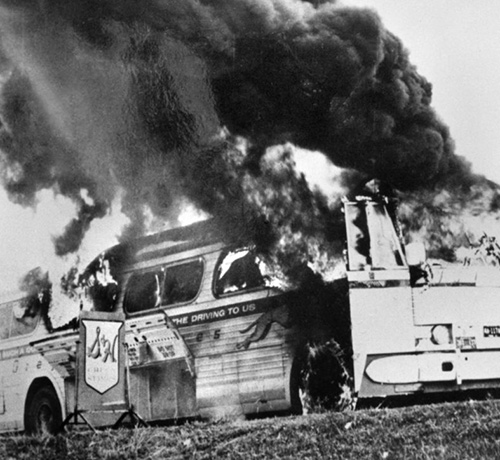 In Anniston, Alabama, segregationists hurled a fire bomb
into a Freedom Rider bus on May 14, 1961. (AP Photo)
In Anniston, Alabama, segregationists hurled a fire bomb
into a Freedom Rider bus on May 14, 1961. (AP Photo)
When the Freedom Riders’ bus arrived in Anniston, Alabama, on May 14, 1961, it was met by a mob of white men armed with pipes, chains, and bats, who smashed windows, slashed tires, and dented the sides of the bus.
315
Barrington M. Solman, “Freedom Riders Civil Rights Legacy Endures,” Washington Informer, May 12, 2011.
Police arrived 20 minutes after the attack began and made no arrests. They escorted the crippled bus to the city limits and then abandoned it.
316
Raymond Arsenault, Freedom Riders: 1961 and the Struggle for Racial Justice (New York: Oxford University Press, 2011), 94-96.
When flat tires forced the driver to stop at a service station shortly after, another armed white mob trapped the riders in the bus and threw a firebomb inside, then viciously beat the riders who escaped.317
Raymond Arsenault, “Freedom Riders,” NPR (2005), https://www.npr.org/2006/01/12/5149667/get-on-the-bus-the-freedom-ridersof-1961.
Two days later in Birmingham, police chief Eugene “Bull” Connor allowed a white mob of several hundred people to attack the riders with baseball bats, hammers, and pipes, leaving several seriously injured.318
Ibid.
The next day, a new group of riders continued on to Montgomery, where they were abandoned by police and attacked by a white mob of 200 people at the downtown Greyhound bus station. About 20 people were injured in the attack, including
reporters and photographers covering the Freedom Rides for national media.319
St. Louis (Mo.) Post-Dispatch “U.S.-Alabama Showdown Near After Mob Resumes Rioting in Montgomery,” May 22, 1961.
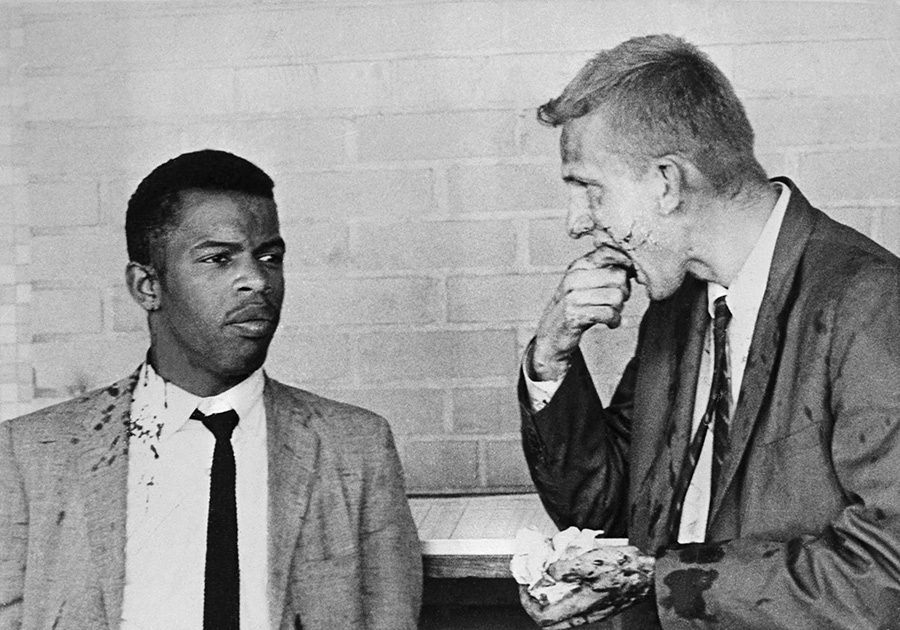
On May 20, 1961, two Freedom Riders, John Lewis (left) and James Zwerg (right), were brutally beaten by segregationists in Montgomery, Alabama. (Bettmann/Getty Images)
That evening, civil rights leaders including Dr. Martin Luther King Jr. and Reverend Fred Shuttlesworth organized an evening service at Montgomery’s First Baptist Church in support of the riders. While more than 1000 people sang and listened to sermons inside the church, white men surrounded the building, vandalized parked cars, and threatened to set the church on fire. When federal marshals tried to intervene, they were pelted with bricks and bottles by white rioters, who then overturned cars, fired bullets and firebombs at local Black residents, and attacked Black people in the street.320 National Park Service, “National Register of Historic Places: African American History Month Feature 2012 - Montgomery Greyhound Bus Station” (2012), https://www.nps.gov/nr/feature/afam/2012/montgomery_greyhound_bus_station.htm.
Alabama Governor John Patterson refused to condemn the white rioters, and instead blamed the Freedom Riders for the violence they suffered in Alabama. During his 1958 campaign, Patterson had warned that integration would cause “violence, disorder, and bloodshed” and had refused to repudiate an endorsement from the Ku Klux Klan.321 Klarman, From Jim Crow to Civil Rights, 431.
“If the Federal Government really wants to help in this unfortunate situation,” Patterson told reporters in Montgomery, “they will encourage these outside agitators to go home. We have the means and the ability to keep the peace in Alabama without any outside help.”322 ”U.S.-Alabama Showdown Near.”
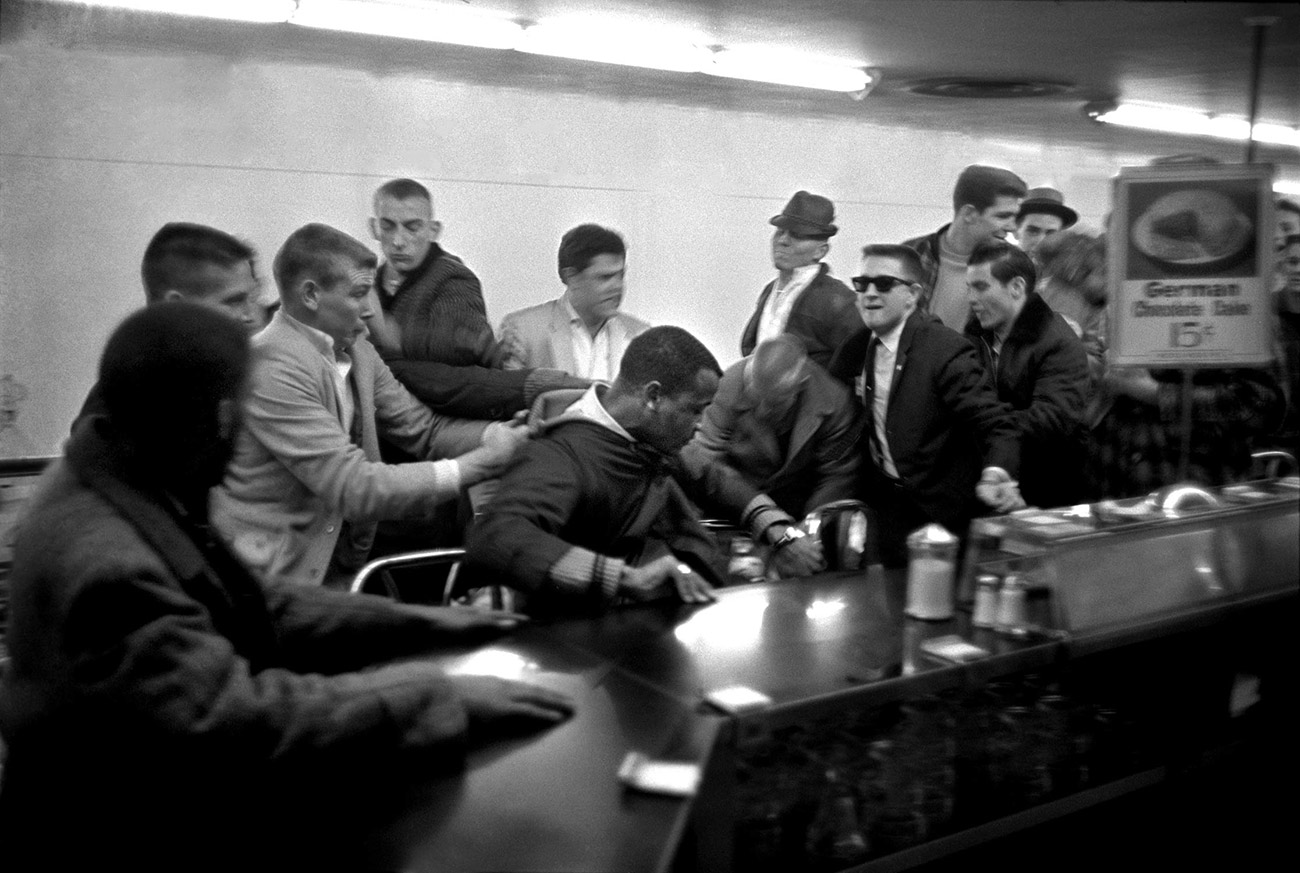
On February 27, 1960, young white men attack a sit-in demonstrator at Woolworth’s lunch counter in Nashville, Tennessee.
(Jimmy Ellis/Nashville Public Library)
We had to flee in the night. We are the American refugees from the terror in the South, all because we wanted to vote.
—Gus Courts, Testimony before Senate committee, February 28, 1957.
To cultivate the support of white constituents, Southern politicians seized every opportunity to denounce racial progress and incite white people’s outrage.
Senator James Eastland from Mississippi, known as “The Voice of the White South,”323 ”Senator James Eastland,” The Mike Wallace Interview, July 28, 1957. unashamedly fanned the flames of racial violence in Belzoni, Mississippi, where Reverend George Lee, local NAACP co-founder and the first Black voter to register in the county since Reconstruction, was shot to death on May 7, 1955. Soon after, activist Gus Courts was ambushed and shot, forcing his family to “flee in the night” as “American refugees from the terror in the South, all because we wanted to vote.” 324 Richmond (Ind.) Palladium-Item, “Negro Says He Had to Leave Home After He Tried to Vote,” March 1, 1957. After these shootings, Eastland told a White Citizens’ Council meeting in Belzoni: “My friends, we are engaged in one of the greatest conflicts in the history of our country.” He encouraged his constituents to identify as soldiers defending their whiteness under siege. “The fight to protect our racial identity,” Eastland declared, “is basic to our whole civilization.”325 Senator James O. Eastland, speech at White Citizens’ Council meeting, Belzoni, Mississippi, September 25, 1957.
By 1963, John F. Kennedy had been elected president, Lyndon Johnson was his vice president, and white segregationists feared the White House was too cozy with civil rights leaders. In 1961, President Kennedy and Attorney General Robert Kennedy negotiated
safe passage out of Alabama for Freedom Riders, and in 1963 the president used federal power to force Alabama Governor George Wallace to stand down as Black students enrolled at the state’s flagship university. By May 1963, polls reported that
62 percent of white Southerners felt that the Kennedy administration was “pushing racial integration too fast.”326
Mildred A. Schwartz, “Trends in White Attitudes Toward Negroes,” Natl. Opinion Research Center (1967): 102.
Strom Thurmond denounced Kennedy’s proposed civil rights legislation as “a vicious, dangerous, and impractical program” that was “unconstitutional, un-American,” and “lined with bribes and Blackmail.”327
Florence (S.C.) Morning News, “Thurmond Fires Three Blasts At Kennedy Rule and Court,” July 5, 1963.
After Kennedy was assassinated on November 22, 1963, Lyndon Johnson, now president, again faced pressure from civil rights leaders to pass civil rights legislation. This time, he worked to pass the bill that Kennedy had proposed. The
sweeping Civil Rights Act of 1964 — which outlawed discrimination in employment, education, and public accommodations328
Burlington (N.C.) Daily Times-News, “Interpretation Given of New Civil Rights Act,” July. 16, 1964.
— passed despite Southern lawmakers’ rabid opposition, public condemnation, and racist rhetoric both on and off the Congressional Record.
In the House, the legislation was described as containing “vicious assaults upon the Constitution.”
329
Bridgeport (Conn.) Telegram, “Debate Begins in House on Civil Rights Measure,” February 1, 1964.
In the Senate, Southerners condemned the Civil Rights bill as “unnecessary, unwise, and beyond the realm of reason.”330 0 Todd S. Purdum, An Idea Whose Time Has Come: Two Presidents, Two Parties, and the Battle for the Civil Rights Act of 1964 (New York: Henry Holt & Co., 2014), 62. They told their constituents it was a “complete blueprint for the totalitarian state,” “a threatened crime against the whole philosophy of liberty,”331 Ibid. and that it would “confer the power of dictatorship . . . upon the president.”332 Ibid., 81.
Senator Allen Ellender of Louisiana proclaimed that African Americans would never gain acceptance until they obtained “the moral, intellectual, and cultural standards of the white race . . . one need only look to Ethiopia, Liberia, or Haiti to put an end to the charge that the white man has kept the Negro from improving himself.” 333 Keith M. Finley, Delaying the Dream (Baton Rouge: Louisiana State University Press, 2008), 264.
In 1965, President Johnson oversaw passage of the Voting Rights Act, which outlawed most of the policies that disenfranchised Black voters in the South, established clear standards and enforcement provisions for challenging violations of voting rights, and directly threatened the seats of many Southern politicians.334 German Lopez, “How the Voting Rights Act Transformed Black Voting Rights in the South, in One Chart,” Vox, August 6, 2015.
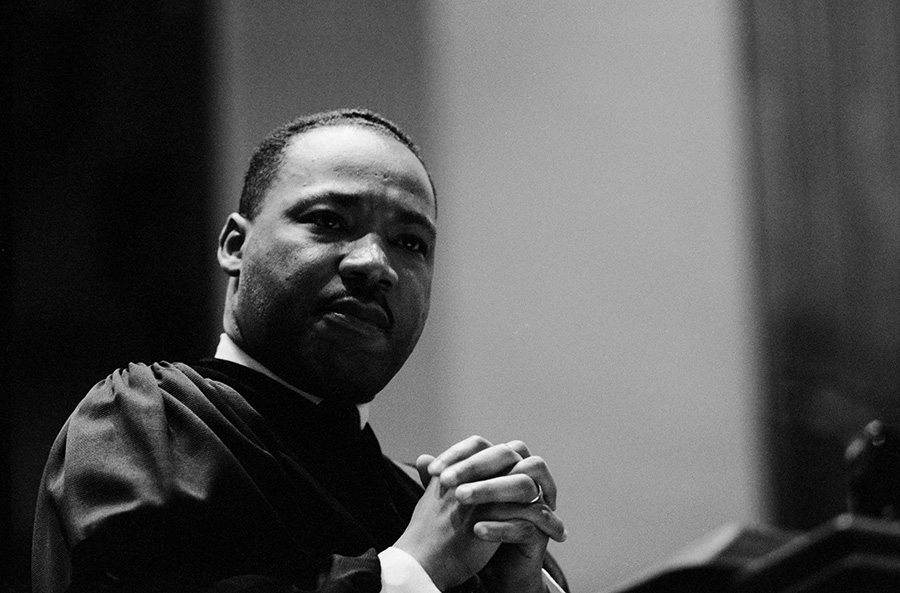
Reverend Dr. Martin Luther King Jr. delivers a sermon at Ebenezer Baptist Church, in Atlanta, Georgia. (Photo by © Flip Schulke/CORBIS/Corbis via Getty Images)
Today, Dr. Martin Luther King Jr. is among the most recognized and revered leaders of the Civil Rights Movement. But during his lifetime, the eloquent minister’s prominence as a national figure, and his skill as a spokesman and leader, attracted powerful opposition.
Dr. King was arrested more than a dozen times for leading nonviolent civil rights demonstrations;335
The King Center, “FAQs,” http://www.thekingcenter.org/faqs.
repeatedly threatened with violence and hanged in effigy;
336
W.J. Weatherly, “The Man in Montgomery,” The Guardian, May 24, 1961.
and covertly targeted by FBI officials who labeled him “the most dangerous and effective Negro leader in the country.”337
“Final Report of the Select Committee to Study Governmental
Operations with Respect to Intelligence Activities,” U.S. Senate (April
26, 1976): 11-12 (internal quotation marks omitted).
"From late 1963 until his death in 1968, Martin Luther King, Jr.,
was the target of an intensive campaign by the Federal Bureau of
Investigation to neutralize him as an effective civil rights leader. In
the words of the man in charge of the FBI’s war against Dr. King, 'No
holds were barred.' . . . In early 1968, Bureau headquarters
explained to the field that Dr. King must be destroyed because he
was seen as a potential messiah who could unify and electrify the
Black nationalist movement. Indeed, to the FBI he was a potential
threat because he might abandon his supposed obedience to white
liberal doctrines (non-violence). In short, a non-violent man was to
be secretly attacked and destroyed as insurance against his abandoning
non-violence."
In 1966, a poll revealed that 63 percent of Americans held a negative view of Dr. King338 Frank Newport, “Martin Luther King Jr.: Revered More After Death Than Before,” Gallup News, January 16, 2016, http://news.gallup.com/poll/20920/martin-luther-king-jr-revered-more-after-deaththan-before.aspx. — reflecting the majority’s deep-seated opposition to civil rights. When he was shot and killed on a Memphis hotel balcony on April 4, 1968, national newspapers reported widespread shock and sorrow, and leaders like President Lyndon Johnson and Senator Robert Kennedy urged the nation to unite in his memory.339 Rocky Mount (N.C.) Telegram, “Reaction to King’s Death,” April 8, 1968; Columbus (Ind.) Republic, “Sen. Kennedy Carries Primary Battle Here,” April 10, 1968.
But many of those who disfavored Dr. King remained hostile to him. White youth openly celebrated Dr. King’s murder in school and on the streets. 340 Cecil Brown, Dude, Where’s My Black Studies Department? The Disappearance of Black Americans From Our Universities (Berkeley: North Atlantic Books, 2007), xi (recounting filmmaker Michael Moore’s recollection of seeing white people cheer news of Dr. King’s assassination when Moore was 13); Mosi Secret, “The Way to Survive it was to Make A’s,” New York Times Magazine, September 7, 2017 (reporting that dorm of white male students at a private prep school in Lynchburg, Virginia, laughed and celebrated news of Dr. King’s assassination on the night he died, in the presence of two Black students who had integrated the campus months before). A study conducted 12 days after the assassination found that 59 percent of Southern white schoolchildren — including 73 percent of white boys — said they were indifferent to or pleased by Dr. King’s murder, and these responses correlated to the children’s perception of their parents’ views.341 James W. Clarke and John W. Soule, “How Southern Children Felt About King’s Death,” in The Changing South, ed. Raymond W. Mack (Piscataway: Aldine Publishing, 1970), 72-74.
Adults were less public — but not silent — about their hostility. On April 10, the Jackson, Mississippi, Clarion-Ledger ran a column that called Dr. King “a victim of his own doctrine” and equated the nonviolent civil rights protests he led with the fatal gunshot that killed him. “This is the bitter fruit of anarchy,” wrote Tom Ethridge, “because once people are persuaded that they have a moral right to violate the law, there is no telling where it will end or who will be victims.”342 Tom Ethridge, “Mississippi Notebook,” Jackson (Miss.) Clarion Ledger, April 10, 1968.
The same day, the Journal Star (in Lincoln, Nebraska) printed an anonymous letter:
Dr. King and his followers have said we have a sick nation, but I feel that we have a sick President, who would proclaim a national day of mourning and the flags flown at half-mast on all government installations, in honor of a man who, wherever he went, caused in this nation violence and destruction.
I don’t believe that any person, Black or white, whose mere presence in that city caused riots and chaos, should be nationally honored. . . . All of us in our own way fight for what we believe in, but we don’t get honored if it is a destructive fight.343 Lincoln (Neb.) Journal Star, “No Honor,” April 10, 1968.
Lester Maddox, Georgia’s segregationist governor, refused to allow Dr. King to lie in state.344 Errin Haines, “King Funeral, Tributes, Reflect Gains of Civil Rights Movement,” Montgomery (Ala.) Advertiser, February 4, 2006. More than 15 years later, an effort to honor Dr. King with a federal holiday became mired in controversy. Senator Jesse Helms of North Carolina denounced Dr. King as a “Marxist” who remained “a source of tension” and did not represent the kind of “shared values” warranting a national holiday.345 Helen Dewar, “Helms Stalls King’s Day in Senate,” Washington Post, Ocober. 4, 1983. Strom Thurmond, John Stennis, Russell Long, and other aging segregationists voted against the bill, but it passed and became law in 1983.346 Alex Brummer, “Senate Approves Luther King Day,” The Guardian, October 20, 1983.
Opposition to civil rights and racial equality cannot be dismissed as the extremism of a few marginalized vigilantes. Like the lynchings prevalent in generations past, school closures, economic reprisals, arrests and harassment, mob violence, bombings, and murder were bold, public acts that implicated the entire community.
Hundreds, if not thousands, of white jurors refused to hold white people accountable for crimes committed against Black activists. Thousands of law enforcement officials and officers failed to protect Black citizens from harassment, attacks, shootings, and bombings, and many police violently abused and even killed Black activists. Public officials who spouted racist rhetoric from their campaign podiums, shut down public schools and parks to prevent integration, and encouraged violence against civil rights activists represented white citizens who applauded their speeches, endorsed their actions, and repeatedly re-elected them to local, state, and national office.347 Klarman, From Jim Crow to Civil Rights, 399-403.
People like James Eastland, Strom Thurmond, and George Wallace portrayed white Southerners as patriots rather than racists; as brave protectors of their culture rather than perpetrators of violent attacks against men, women, and children; and as defenders of state sovereignty against an overreaching federal government intent on destroying their way of life rather than violators of constitutional rights. “We are about to embark on a great crusade,” Eastland told a gathering of pro-segregation activists in 1955. “A crusade to restore Americanism and return the control of our government to the people.”348 Jackson (Miss.) Clarion-Ledger, “Coordinating Group Formed to Promote South’s Segregation,” December 29, 1955.
Opponents of racial equality embraced this identity, which empowered them to cast their immoral behavior as moral and to feel pride rather than shame as they used economic intimidation, criminalization, bombings, beatings, and even murder to defend white supremacy. This identity became the civil rights era’s most enduring legacy.
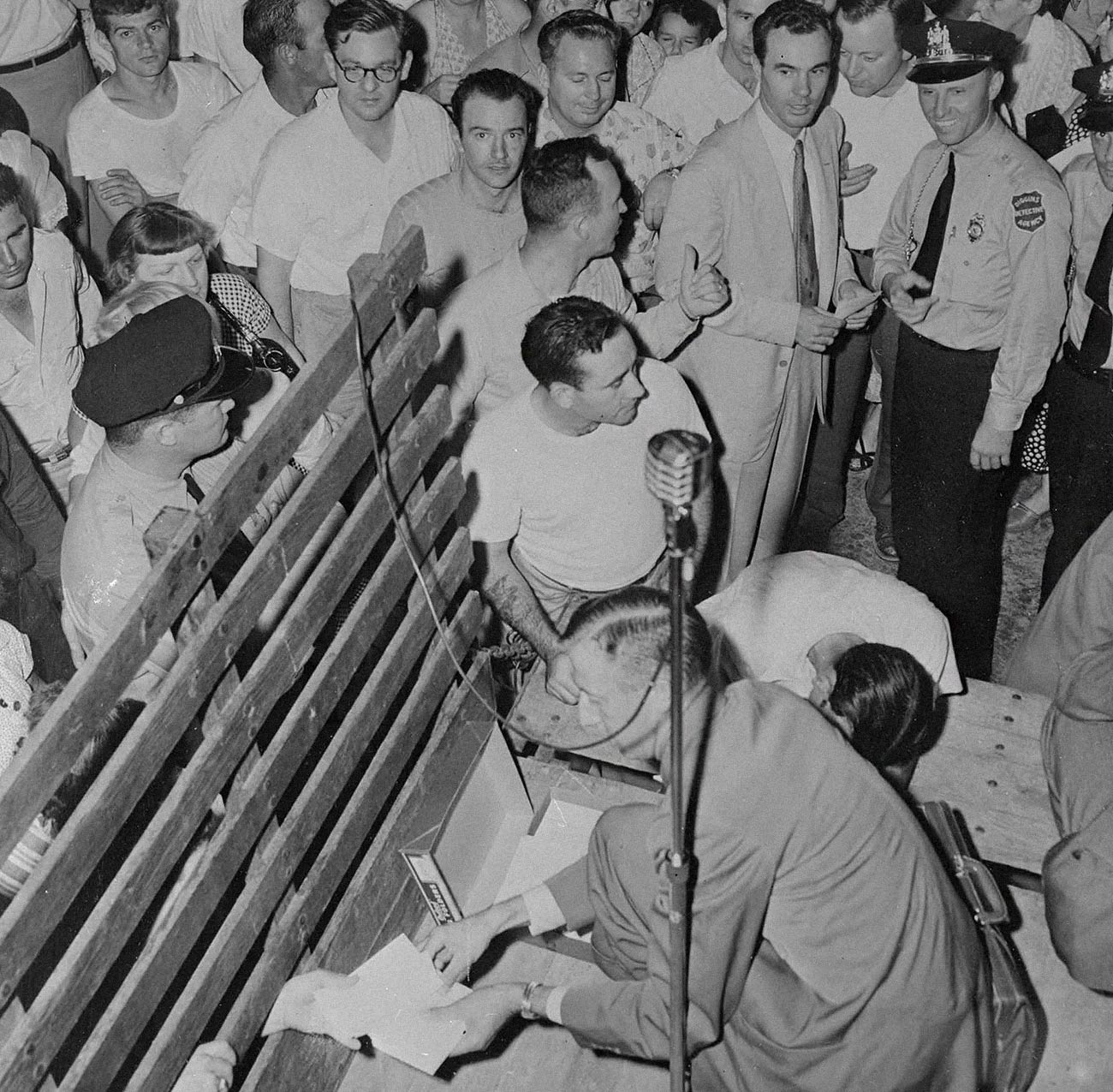
The National Association for the Advancement of White People holds a rally on October 5, 1954, featuring its president, Bryant Bowles, who led a successful effort to halt desegregation in Milford, Delaware. (Bettmann/Getty Images)
The average man in the Northern states agrees entirely with the position that we take...
— Senator James Eastland, White Citizens’ Council Meeting in Mississipi, 1957.349 Eastland, speech in Belzoni.
White opposition to civil rights was largely a Southern movement, but it spread quickly. Between 1941 and the late 1970s, some five million African Americans fled to the North and West, marking the first time in American history that a large proportion of African Americans lived outside the South.350 Joe W. Trotter and Kenneth L. Kusmer, African American Urban History: The Dynamics of Race, Class and Gender since World War II (Chicago: University of Chicago Press, 2009), 21. Southern segregationists saw potential allies in the North and West.
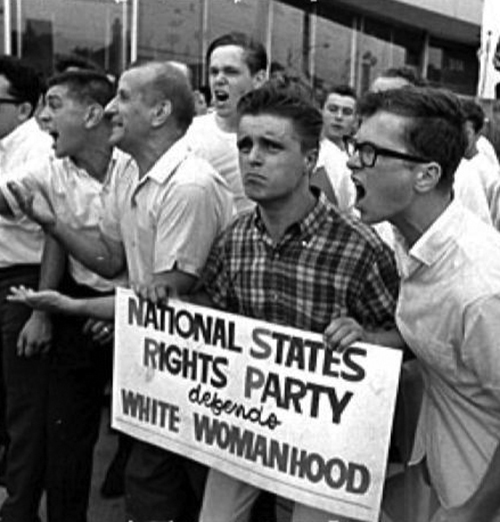 White residents of Chicago's northwest side shout and shake their fists at civil rights marchers
protesting racial discrimination in housing, August 7, 1966. (AP Photo/stf)
Television cameras recorded Dallas County Sheriff Jim Clark’s brutal beating of Reverend C.T. Vivian in Selma, Alabama, during a February 1965 voting rights demonstration. When it was broadcast on television, Clark received fan mail from across the country.
“Sorry there are not enough men with your guts and convictions in this country,” read one wire from Porterville, California. “Seventy percent of the messages are favorable,” Clark told a reporter, “and more of it’s favorable from the North than
the South.”351
Jack Nelson, “Clark Gets ‘Fan Mail’ in Selma Rights Fight,” Los Angeles Times, February 18, 1965.
Later that year, Clark was the invited speaker at a meeting of the Los Angeles White Citizens’ Council, where he condemned the Watts uprising as the fault of “Martin Luther King and company and the Communist conspiracy.”352
Fresno (Calif.) Bee, “Sheriff Ignores Pickets During Pasadena Talk,” November 16, 1965.
Meanwhile, Reverend Vivian, an aide to Dr. Martin Luther King Jr., was charged with contempt of court.353
Nelson, "Clark Gets ‘Fan Mail’ in Selma Rights Fight," February 18, 1965.
White residents of Chicago's northwest side shout and shake their fists at civil rights marchers
protesting racial discrimination in housing, August 7, 1966. (AP Photo/stf)
Television cameras recorded Dallas County Sheriff Jim Clark’s brutal beating of Reverend C.T. Vivian in Selma, Alabama, during a February 1965 voting rights demonstration. When it was broadcast on television, Clark received fan mail from across the country.
“Sorry there are not enough men with your guts and convictions in this country,” read one wire from Porterville, California. “Seventy percent of the messages are favorable,” Clark told a reporter, “and more of it’s favorable from the North than
the South.”351
Jack Nelson, “Clark Gets ‘Fan Mail’ in Selma Rights Fight,” Los Angeles Times, February 18, 1965.
Later that year, Clark was the invited speaker at a meeting of the Los Angeles White Citizens’ Council, where he condemned the Watts uprising as the fault of “Martin Luther King and company and the Communist conspiracy.”352
Fresno (Calif.) Bee, “Sheriff Ignores Pickets During Pasadena Talk,” November 16, 1965.
Meanwhile, Reverend Vivian, an aide to Dr. Martin Luther King Jr., was charged with contempt of court.353
Nelson, "Clark Gets ‘Fan Mail’ in Selma Rights Fight," February 18, 1965.
As civil rights gains spread, white residents of major cities outside the South blocked efforts to end racial discrimination in housing, education, and public services. Elected officials used legislation and violence to fight racial equality, deny Black people access to public services, and exacerbate the poverty that plagued Black neighborhoods.
Some of the earliest clashes took place in border states like Maryland and Delaware. By 1950, Baltimore had six whites-only swimming pools; the one pool for African Americans was so crowded that children had to swim in shifts.354 Laura Wexler, “Swimming in the City,” Baltimore Style (July-Aug.2008). Threats of violence delayed implementation of a 1956 court order to integrate the pools, and in 1962, a mob of 1000 white people threw stones and bottles at African American children swimming in a traditionally white pool.355 Cumberland (Md.) News, “Negro Leader Demands Baltimore Police Probe,” September 19, 1962.
In 1960, 90 percent of Baltimore restaurants refused to serve African Americans.356 Peter Irons, The Courage of Their Convictions (New York: Penguin,1988), 131. When a group of high school and college students boycotted a segregated lunch counter, Chief Judge of the Maryland Court of Appeals Robert Bell recounted:
People were spitting and yelling and screaming at us; the epithets were ones you would imagine they would be in the context of that situation. Some people on the picket line were hit, although there was not as much physical violence as I thought there might be. The police were standing about, watching, but they didn’t intervene to protect us from getting hit and they didn’t arrest anyone.357 Ibid., 143
When 11 Black students integrated the white high school in the southern Delaware town of Milford in fall 1954, the local school board president predicted it would “blow the town apart.”358 Orlando Camp and Ed Kee, “Lost Opportunity: The Failure to Integrate Milford’s Public Schools in 1954,” in Choosing Equality: Essays and Narratives on the Desegregation Experience, eds. Robert L. Hayman Jr. and Leland Ware (University Park: Pennsylvania State University Press, 2009), 137; Orlando Camp and Ed Kee, The Milford Eleven (Wilmington: Cedar Tree Books, 2011), 32. Plans for a school dance triggered a mass meeting attended by some 1500 white residents, and after 800 people signed a petition opposing an integrated dance,359 Nashville (Tenn.) Southern School News, “Delaware,” October 1,1954. school officials canceled the event. 360 Camp & Kee, Lost Opportunity, 142. The Black students were told to stay home for several days, and when they returned to school, police had to escort them through mobs shouting, “The Bible gives authority for segregation!” and “We just don’t want our children to go to school with Negroes!”361 Ibid., 145-46. Milford expelled the Black students and the NAACP sued, sparking more cross burnings, rallies, and pro-segregation demonstrations. The next year, the Delaware Supreme Court ruled that Milford could delay integration while awaiting guidance from the United States Supreme Court. 362 Raymond Waters, The Burden of Brown: Thirty Years of School Desegregation (Knoxville: University of Tennessee Press, 1992), 200. Segregation persisted in Milford for 15 years, until the last segregated school closed in 1970.363 Camp & Kee, Milford Eleven, 115.
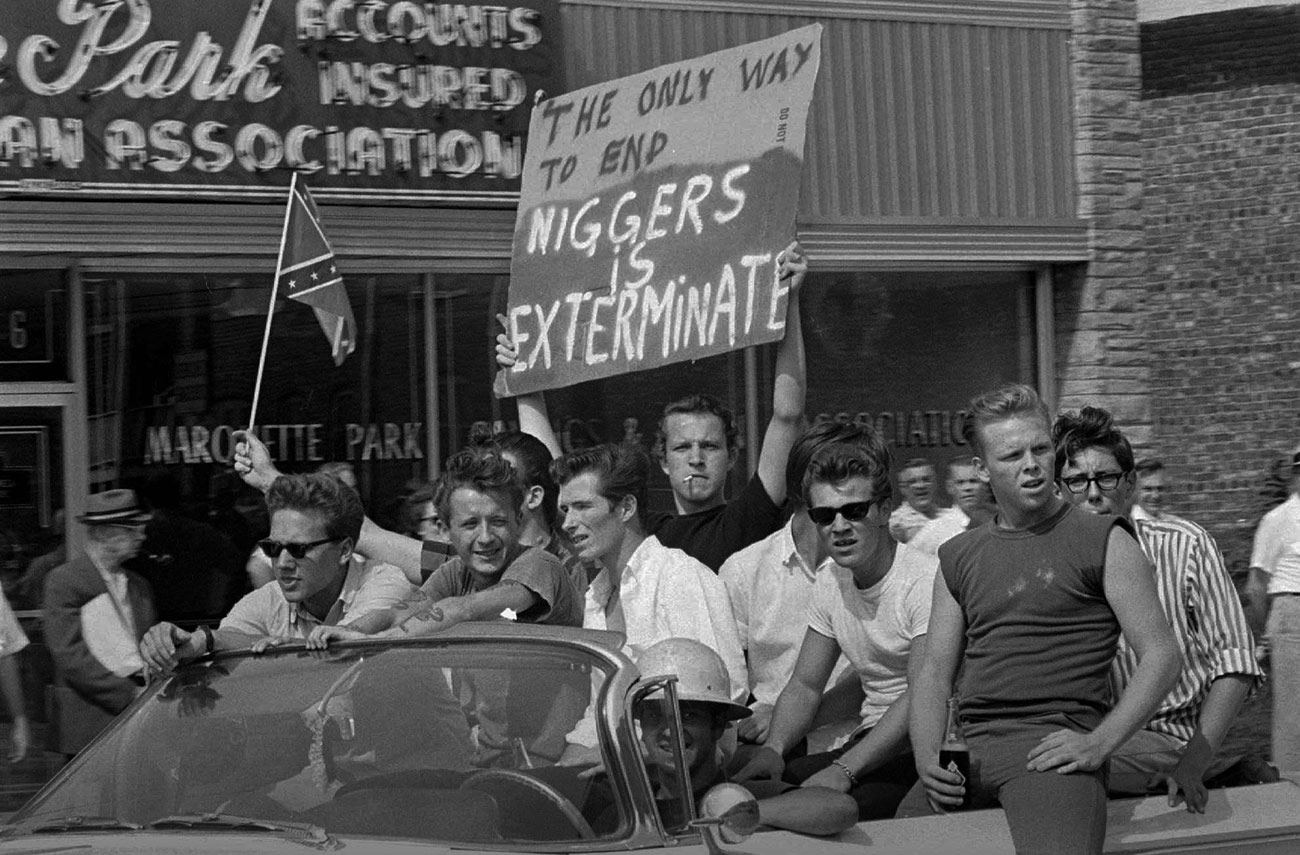
Young white men with a Confederate flag and racist sign jeer at civil rights marchers in the southwest side of Chicago, August 5, 1966. (AP Photo)
Employment discrimination was a major barrier to economic advancement for Black people in the North and West. Hiring restrictions that barred Black people in Detroit and Chicago from many positions and promotions during the 1940s war boom persisted long after the war ended.364 Mark Speltz, North of Dixie: Civil Rights Photography Beyond the South (Los Angeles: J. Paul Getty Museum, 2016), 12. Many trade unions barred Black workers, and non-union employers often offered Black applicants lower pay and lesser positions, if they were hired at all.365 Ibid.
From 1960 onward, the unemployment rate for Black Americans stayed at double the rate for white Americans.366 Algernon Austin, “For African Americans, 50 Years of High Unemployment,” Economic Policy Institute, February 22, 2012. Even after the Civil Rights Act outlawed racial discrimination in employment, job advertisements in the New York Times, Washington Post, and Chicago Tribune sought “white applicants only.”367 William A. Darity Jr. and Patrick L. Mason, “Evidence on Discrimination in Employment: Codes of Color, Codes of Gender,” Journal of Economic Perspectives 12, no. 2 (1998): 64.
Housing segregation shaped urban landscapes in the North, where housing shortages penned Black migrants in overcrowded and overpriced neighborhoods. Housing segregation enabled school segregation, which in many cities remained a vestige of segregated neighborhoods long after segregation laws were struck down.
In Philadelphia, more than 200 African Americans attempting to rent or buy homes at the edges of the city’s segregated residential districts were attacked during the first six months of 1955 alone. Black residents found themselves trapped in the North
Philadelphia ghetto for years.368
Richard Rothstein, The Color of Law: A Forgotten History of How Our Government Segregated America (New York: Liveright Publishing, 2017), 122.
In Los Angeles, more than 100 African Americans were targeted with violence when they tried to move out of segregated Black neighborhoods between 1950 and 1965.369
Ibid.
These attacks, including dynamite bombings, cross burnings, and rocks thrown through windows, led to only one arrest and prosecution.370
Ibid.
 Police beat a Black man in Harlem, New York, in 1964. (AP Photo)
The Chicago Housing Authority invested in segregation by concentrating more than 10,000 public housing units in isolated African American neighborhoods — a policy the Supreme Court found in 1976 violated racial desegregation laws.”371
Hills v. Gautreaux, 425 U.S. 284 (1976).
Police beat a Black man in Harlem, New York, in 1964. (AP Photo)
The Chicago Housing Authority invested in segregation by concentrating more than 10,000 public housing units in isolated African American neighborhoods — a policy the Supreme Court found in 1976 violated racial desegregation laws.”371
Hills v. Gautreaux, 425 U.S. 284 (1976).
Slavery and codified racial segregation have come to be thought of as uniquely Southern phenomena, but it is clear that the legacy of white supremacy and racial bigotry was a powerful force in the North and West. Inspired by Southern
segregationists, there is a clear and undeniable record of pervasive discrimination based on race that spread across America. The legacy of this history haunts us still.